Innovative Research

🧬 Decoding the Silent Genome of Sex Determination 🧬
A fascinating new study led by Dr. Nitzan Gonen and her lab reveals how non-coding regions of DNA, long overlooked, play a critical role in guiding whether embryonic gonads develop into testis or ovary.
By combining novel transgenic mouse models with high-resolution genomic mapping, the team traced the evolution of gene expression and chromatin accessibility during the critical window of sex determination. One of the most compelling insights is that two transcription factors, EMX2 and LHX9, traditionally associated with early gonadal development, may also direct cells toward an ovarian fate, suggesting a far broader role than previously thought.
Why this matters?
Despite significant advances in genetics, more than half of individuals with Differences of Sex Development (DSD) still receive no genetic diagnosis. This research offers a window into the 98% of the genome that doesn’t code for proteins but may hold the key to those unanswered cases.
A major step forward in understanding how fate is written not just in genes but in the regulatory script that surrounds them.
Huge credit to @Nitzan Gonen and colleagues for this significant contribution.
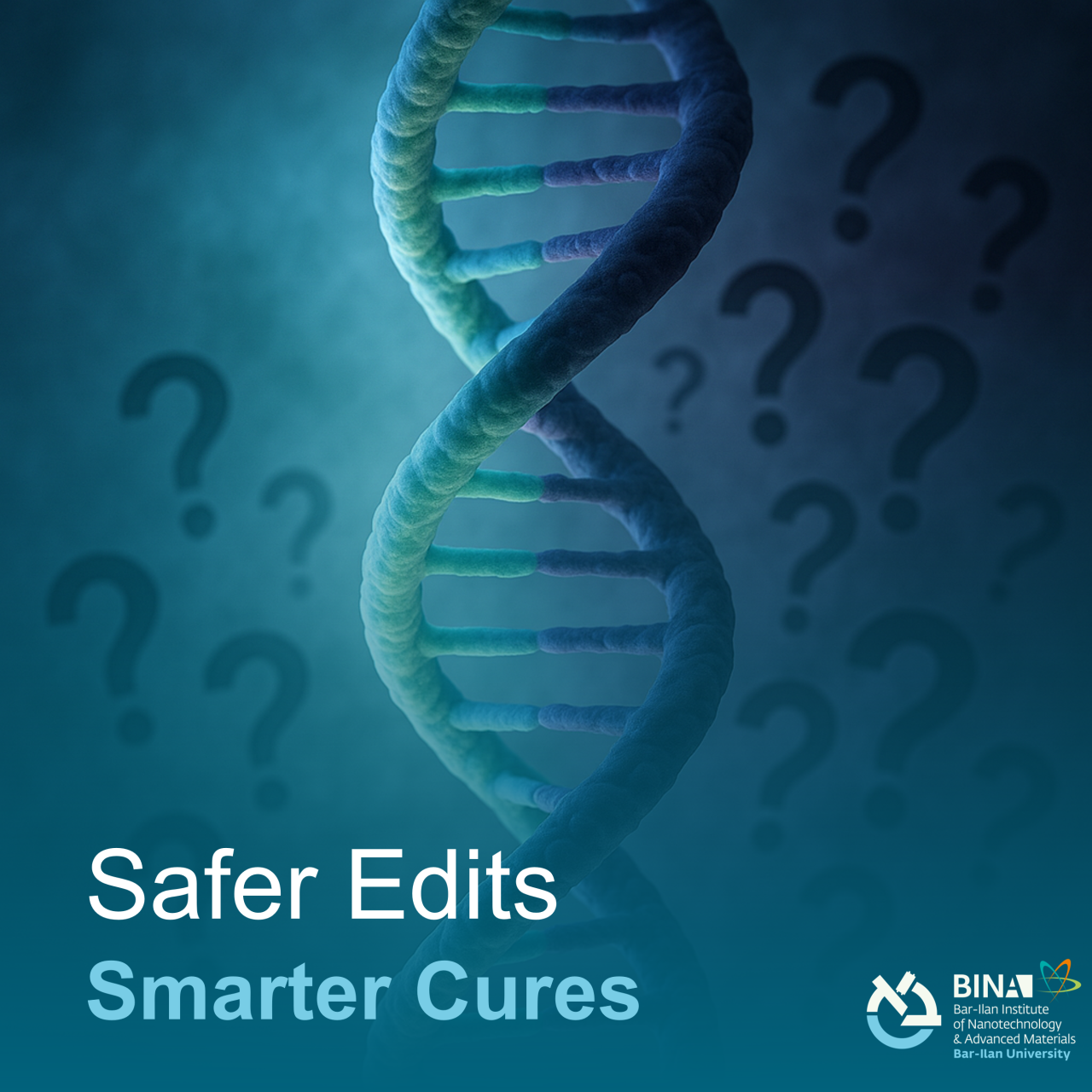 Gene Editing: How Do We Keep It Safe?
Gene Editing: How Do We Keep It Safe?
A new, exciting review led by Prof. Ayal Hendel and an international team of researchers (Germany, Italy, Spain, Denmark, UK, and Ireland) takes on one of the most pressing issues in gene editing: how to prevent unintended edits, known as off-target effects.
CRISPR-based therapies have shown remarkable potential, but questions around safety have slowed their path to the clinic. This paper offers more than just a summary of the risks- it lays out a clear, practical framework to address them.
🔍 Highlights from the work:
Concrete strategies for predicting and minimizing off-target activity
A comprehensive review of tools used to measure genomic safety
A push toward personalized editing, tailored to each patient’s genetic makeup
🧬 Why this matters:
As CRISPR moves closer to real-world therapies, precision is everything. This work sets the groundwork for safer, more reliable treatments, especially for complex diseases like cancer and inherited blood disorders.
Huge credit to Prof. Ayal Hendel, Nechama Kalter, and all partners for driving the field forward in such a meaningful way.
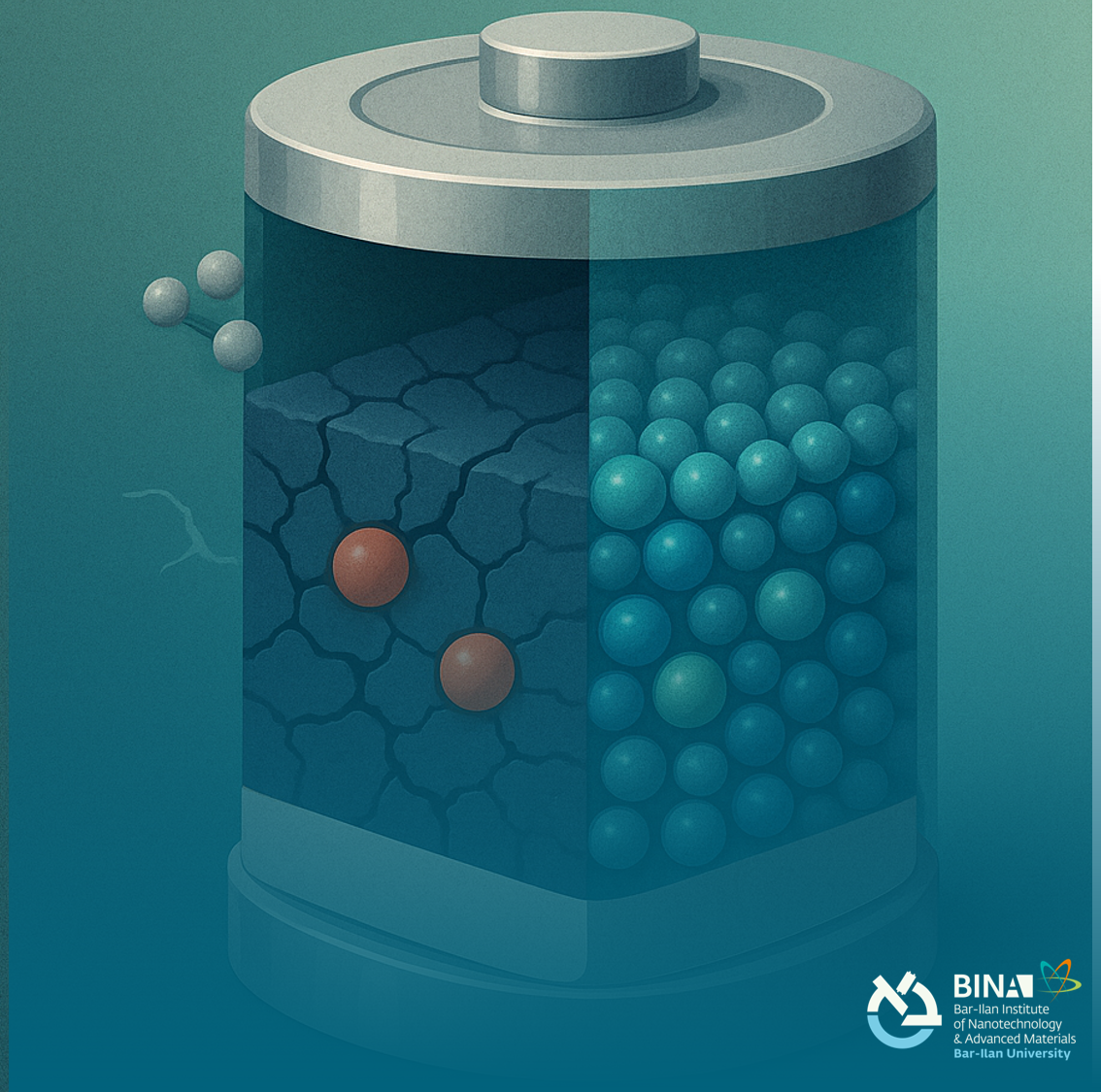 Big news for the future of electric vehicles🔋
Big news for the future of electric vehicles🔋
A new computational study, supported by experimental observations led by Prof. Dan Thomas Major, collaborating with Prof. Doron Aurbach, demonstrates how introducing tiny amounts less than 1% of certain metal dopants into Ni-rich NCM cathodes can dramatically improve lithium-ion battery performance.
These cathodes already offer high energy capacity, but they tend to degrade quickly under cycling. Prof. Major's team found that adding dopants like niobium, tungsten, or molybdenum helps:
- Strengthen the structure by forming tighter bonds with oxygen
- Reduce the amount of unstable and reactive nickel ions
- Stabilize the surface to limit oxygen loss during charge cycles
- Maintain battery performance over time without sacrificing output
What does this mean for the planet? Batteries that last longer, perform more reliably, and waste less material are an essential step toward making electrified transportation more sustainable.
Brilliant work from Prof. Dan Thomas Major, Prof. Doron Aurbach, and the team.
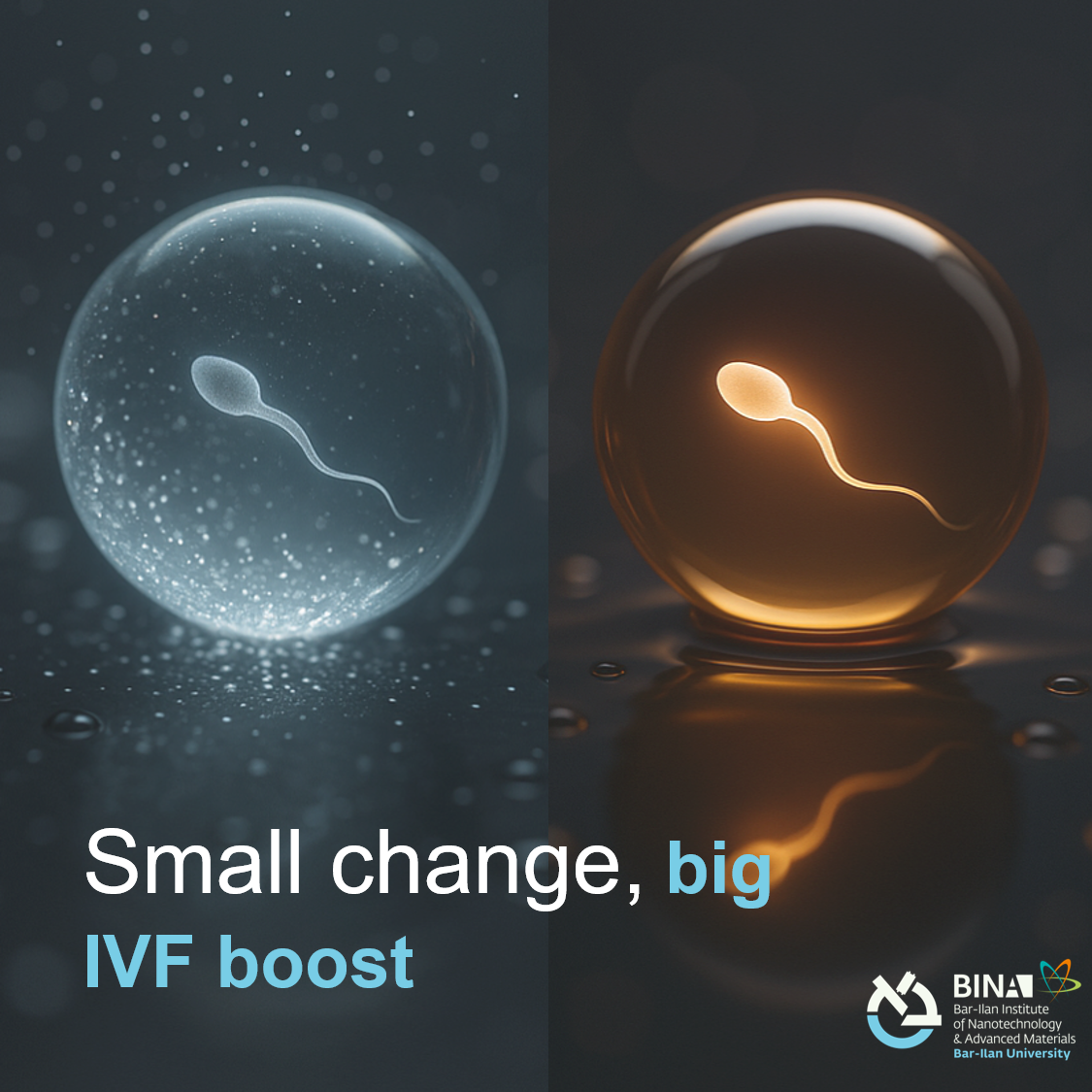 A remarkable step forward in fertility science.
A remarkable step forward in fertility science.
Freezing single sperm cells has always been tricky. For patients with very low sperm counts, every cell matters, yet standard cryopreservation methods either lose cells in the process or, when stored in tiny nanoliter drops, leave them unable to survive thawing.
In a recent study, Bat-Sheva Galmidi, with Prof. Dror Fixler, in collaboration with Sheba Medical Center at Tel HaShomer, uncovered the underlying cause: water gradually diffuses from the droplet into the surrounding oil, which is intended to protect it. This subtle change increases the salt concentration within the droplet, ultimately harming the cells. The research was initiated under the leadership of the late Prof. Mordechai Deutsch, who passed away a few months ago.
Their fix is elegantly simple, using oil already saturated with water. This small change stops the water loss and dramatically improves survival rates.
This innovation could revolutionize IVF treatments, giving hope to patients with minimal viable sperm samples, and may even transform cryopreservation techniques for other biological materials, a leap forward for medicine and science.
 🔥🔭 Smaller. Cooler. Smarter.
🔥🔭 Smaller. Cooler. Smarter.
A breakthrough in thermal imaging is on the horizon, and it’s thanks to Prof. Zeev Zalevsky and Prof. Benjamin Milgrom (from JCT) and their team.
Thermal cameras are used in everything from environmental monitoring to aerospace. But there’s a catch: high-performance models typically require ultra-low cooling to 150K, which makes them bulky, power-hungry, and expensive.
This new research flips the script.
By operating at a warmer 180K- previously thought too noisy for clear imaging and using smart image enhancement techniques to clean up the signal, the team managed to maintain impressive image quality while significantly reducing system size and cost.
📉 Why does it matter?
Running at 180K can cut cooling requirements by 20%, leading to up to 50% savings in camera size and cost. That’s a game changer for applications where weight, power, and space are limited—like drones, satellites, and wearable systems.
Furthermore, field tests demonstrated that even in daylight or low-light settings, the images remained sharp and detailed after processing. No special hardware upgrades are needed, just a shift in thinking.
👏 Hats off to Prof. Zeev Zalevsky for pushing the boundaries of what’s possible in sensing technology.
#InfraredImaging #RemoteSensing #ThermalTech #ZeevZalevsky #SustainableDesign #TechInnovation #NextGenSensors
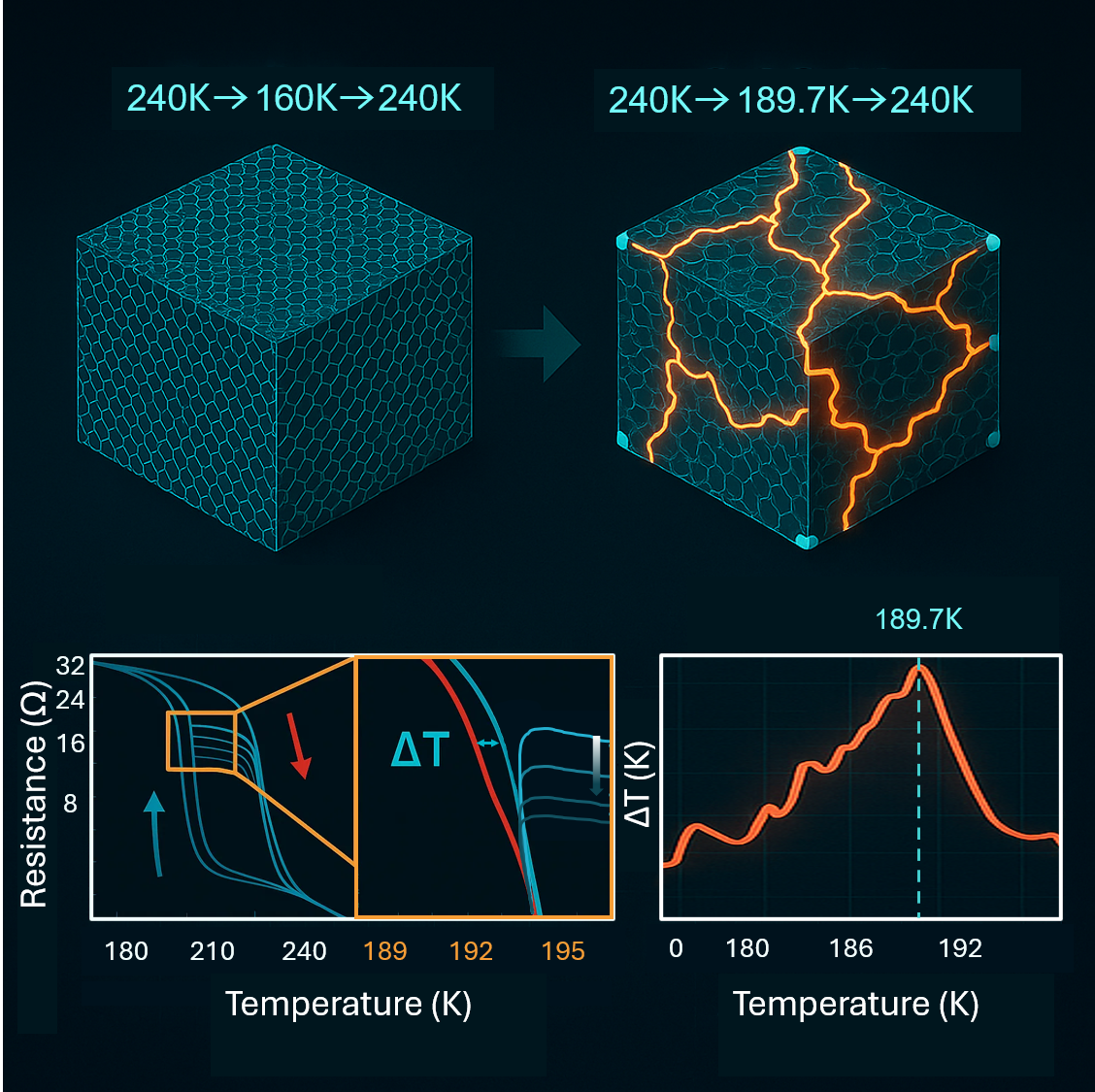 💡 A Surprising New Kind of Memory- Discovered in 1T-TaS₂
💡 A Surprising New Kind of Memory- Discovered in 1T-TaS₂
In a remarkable study, Prof. Amos Sharoni and his team have uncovered a novel memory effect in the layered material 1T-TaS₂. By reversing the direction of temperature change at a specific point, the material effectively “remembers” that moment, altering its resistance in a way that reflects its thermal history.
This kind of memory, known as Ramp Reversal Memory (RRM), was previously observed only in thin-film oxides. But here’s the twist: the effect in 1T-TaS₂ appears in bulk crystals, it occurs during cooling (not heating, as seen before), and it’s an order of magnitude stronger.
🌍 Why it matters:
An exciting leap that blends elegant physics with real potential for technology.
Kudos to Prof. Amos Sharoni, Avital Fried, and the rest of the team on this inspiring work.
🔗 https://doi.org/10.1002/adfm.202504649
#CondensedMatter #PhaseTransitions #MemoryEffect #MaterialsScience #1TTaS2 #AmosSharoni #Nanoscience #BeyondCMOS #Innovation
🚨 Brea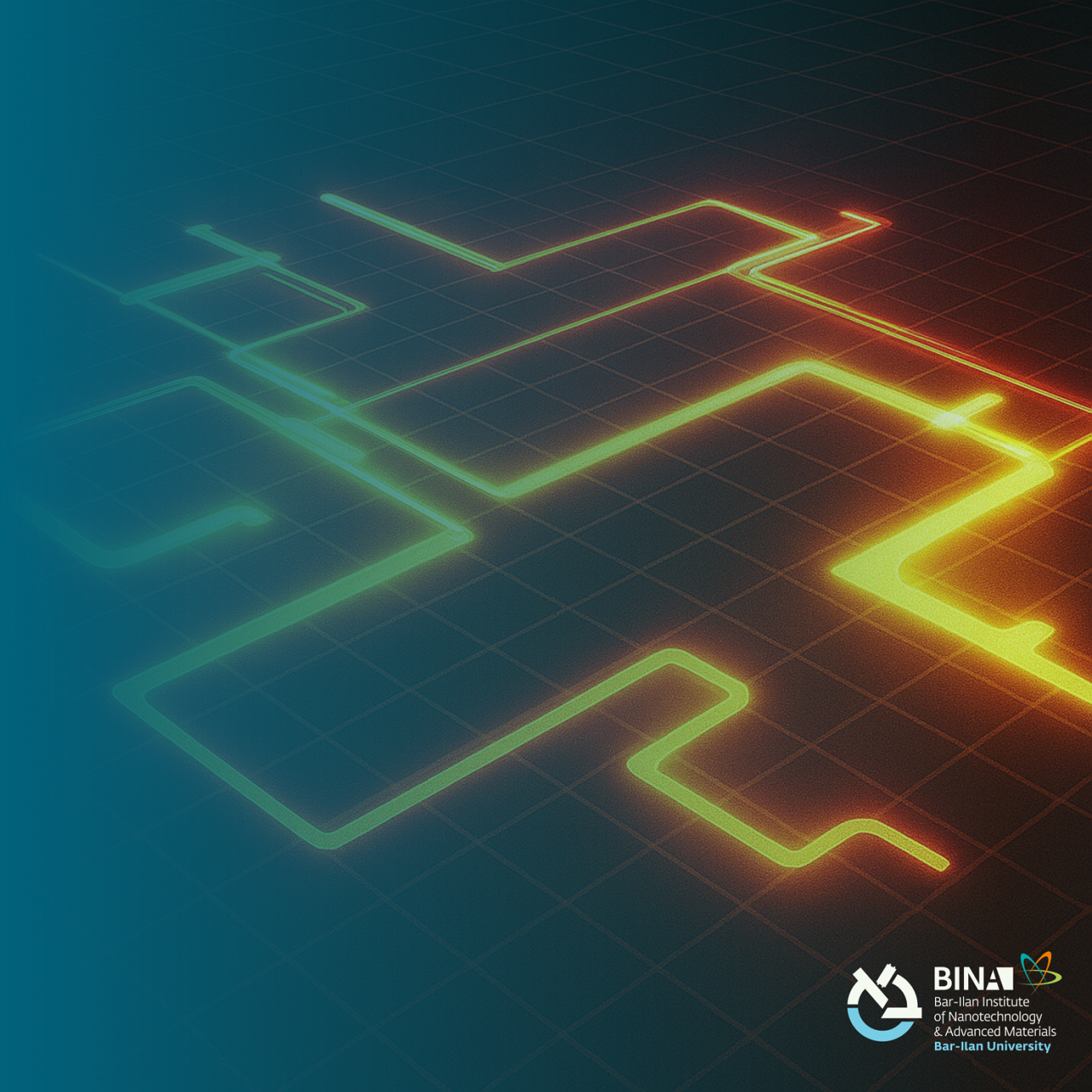 kthrough in understanding abrupt phase transitions!
kthrough in understanding abrupt phase transitions!
A new study led by Prof. Aviad Frydman and collaborators uncovers the hidden dynamics behind sudden system collapses, like blackouts or market crashes, using superconducting networks as a model.
The team discovered that these abrupt transitions aren't just triggered by external shocks. Instead, they're driven by internal, spontaneous, and long-living cascading events, similar to how a single infection can trigger a pandemic. These cascades follow precise scaling laws and occur over surprisingly long timeframes, offering early warning signs before a full system collapse.
Why does this matter? Because it gives us a quantifiable way to measure a system’s resilience and potentially anticipate catastrophic failures in everything from critical infrastructure to ecological systems.
This is a major leap forward in statistical physics and complex systems, and it could reshape how we understand vulnerability and stability across disciplines.
🔗 Read the full article in Nature Communications: https://doi.org/10.1038/s41467-025-61127-z
#Physics #ComplexSystems #Superconductivity #Resilience #ScientificDiscovery #PhaseTransition
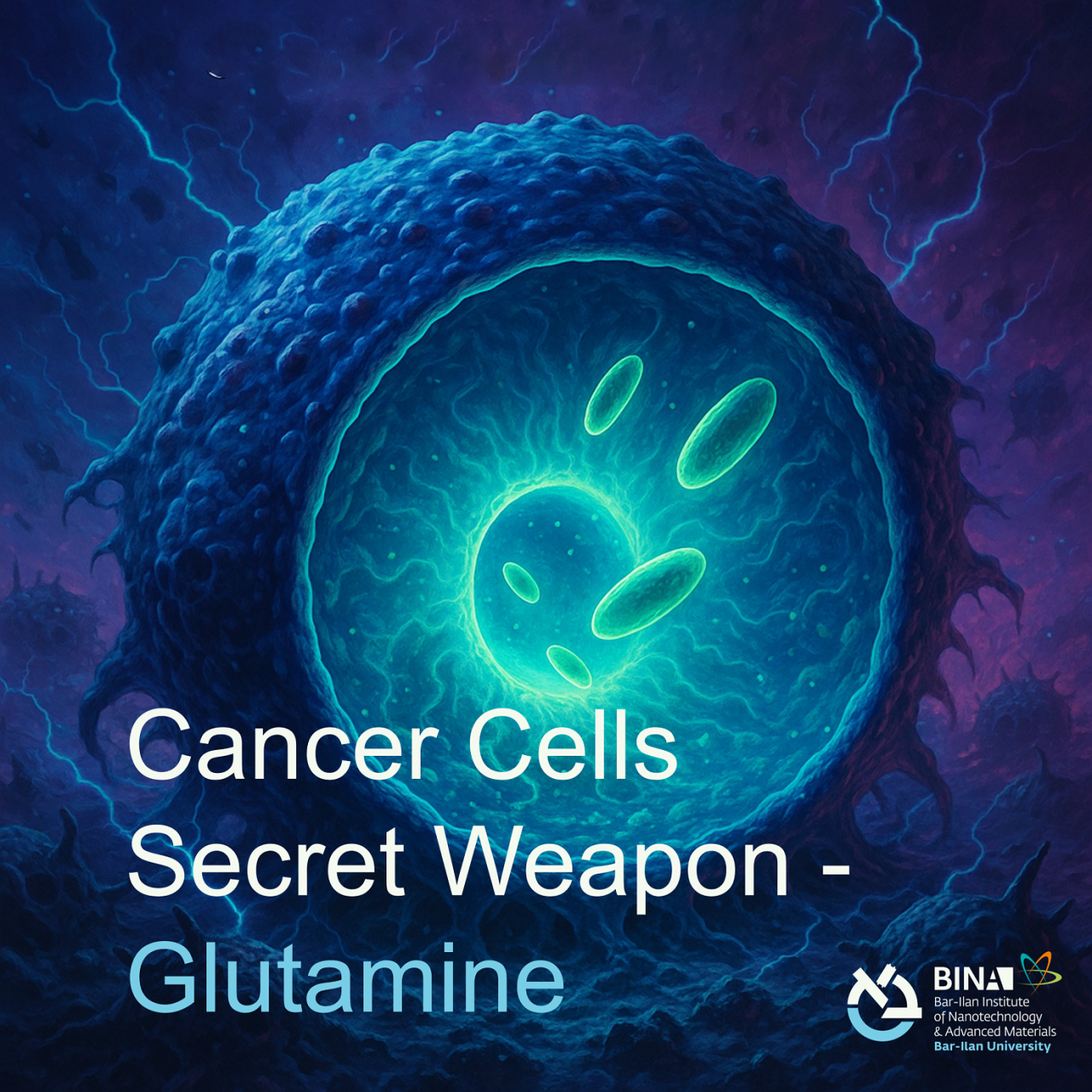
🧬 Can a single amino acid shape how cancer cells survive stress?
Surprisingly- yes. And that amino acid is glutamine.
In a remarkable new collaborative study, Prof. Yaron Shav-Tal, Dr. Dana Ishay-Ronen (Sheba Medical Center, Tel Hashomer), and their team demonstrate that glutamine isn’t just fuel- it’s a critical trigger for survival.
When cancer cells are starved of nutrients and face oxidative stress, their ability to form stress granules- tiny, temporary shelters for RNA- is lost. But when glutamine is reintroduced, this protective mechanism springs back into action, restoring energy levels and boosting cell survival.
What’s striking is how specifically this response is wired. It relies on the metabolic regulator MYC and the RNA-binding proteins G3BP1/2, which together enable cells to reorganize under pressure.
🌍 Why this matters:
This discovery sharpens our understanding of how tumors endure hostile conditions, and it opens the door to new strategies that could interrupt that resilience. By targeting glutamine pathways, we may be able to make cancer cells more vulnerable at their most fragile point.
Huge respect to Prof. Yaron Shav-Tal and his team for revealing such a crucial link between metabolism, stress response, and survival.
#CancerBiology #CellStress #Glutamine #Metabolism #StressGranules #YaronShavTal #BarIlanUniversity #BiomedicalResearch
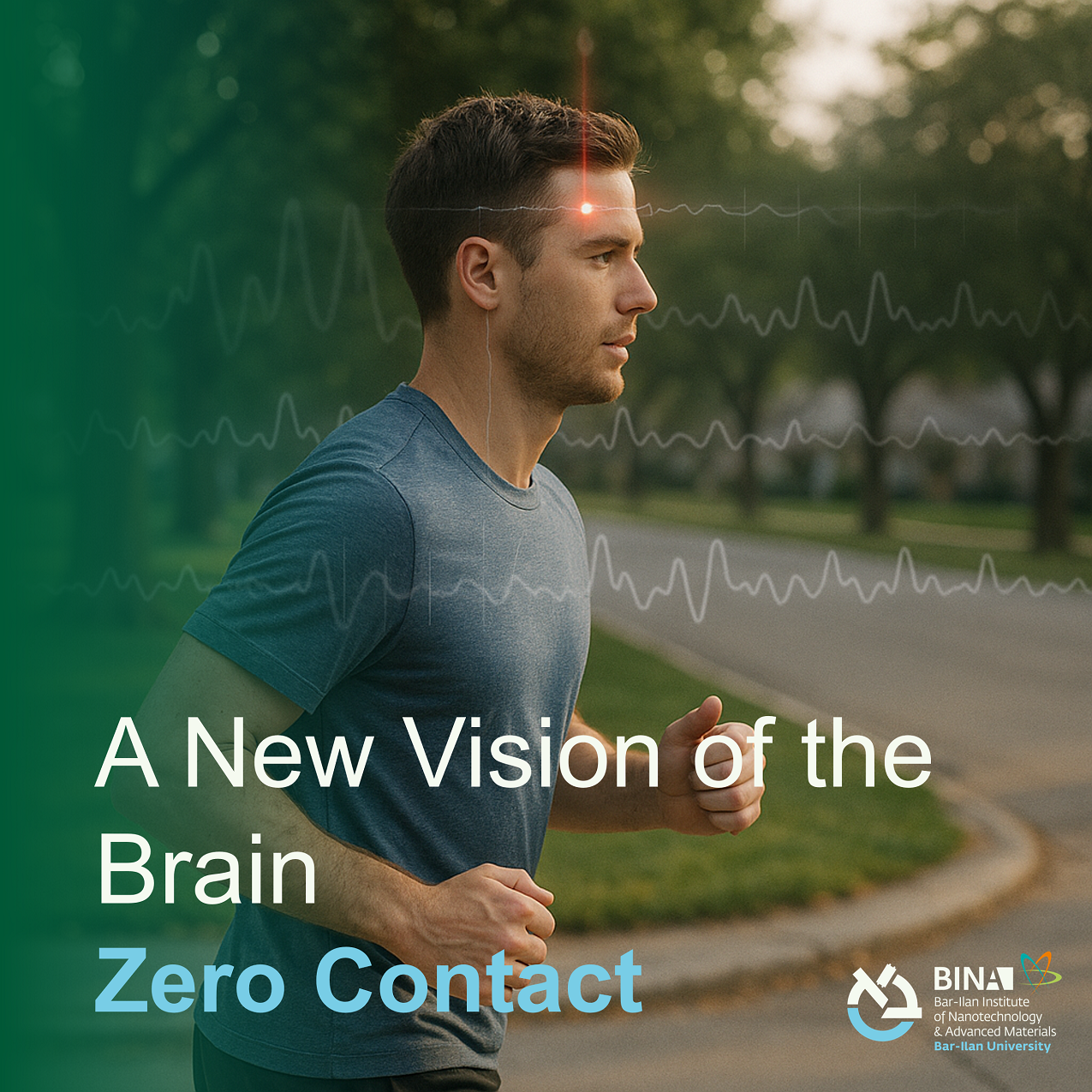
🧠✨ A New Way to See Inside the Brain- Without Ever Touching It
Imagine being able to detect how the brain processes speech, without electrodes, scanners, or even physical contact. That’s exactly what Prof. Zeev Zalevsky, Dr. Yevgeny Beiderman (Holon Institute of Technology), and their team have accomplished.
By combining laser light, a simple camera, and advanced deep learning, the team developed a completely contactless method to monitor real-time brain activity. The system accurately distinguishes between brain responses to comprehensible and incomprehensible speech, reaching 94% accuracy with just a single second of data.
Why is this so exciting?
Because it unlocks a future where:
This is more than a technological step forward. It’s a shift toward making brain diagnostics more human-centered and accessible.
Congratulations to Prof. Zeev Zalevsky and his team for this outstanding contribution to neurotechnology.
#Neuroscience #BiomedicalInnovation #BrainHealth #DeepLearning #RemoteMonitoring #ZeevZalevsky #BarIlanUniversity
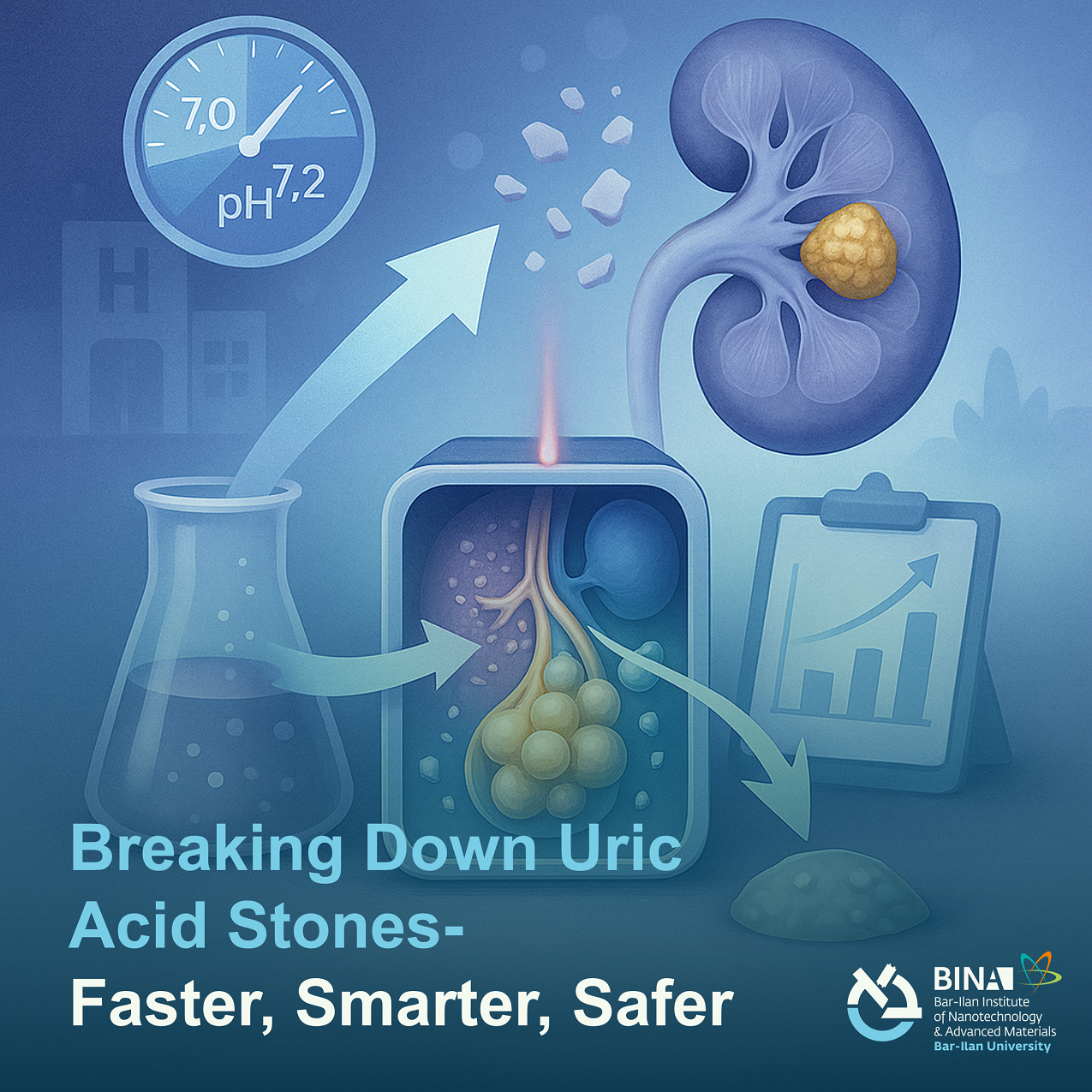 A fresh perspective on uric acid kidney stones- backed by data, not just tradition.
A fresh perspective on uric acid kidney stones- backed by data, not just tradition.
In a joint study with Wolfson & Sheba Medical Centers and Ariel University, led by Dr. Paz Lotan (MD, University of Wisconsin) Prof. David Lifshitz (Department of Urology, Rabin Medical Center) and Prof. Yitzhak Mastai, researchers conducted a comprehensive examination of uric acid stone dissolution, challenging long-held assumptions and providing practical updates to current treatment strategies.
Their findings? Small changes can make a big difference:
Raising urine pH to 7-7.2 significantly boosts stone dissolution, up to nine times faster than at lower pH levels. Even modest fragmentation of the stones drastically improves their dissolution rate, hinting at the value of minimally invasive preparation before or alongside medical therapy. Lowering uric acid levels in the urine only helps if alkalinization is already in place, supporting clinical guidelines that discourage allopurinol use alone in patients without high uric acid levels.
Why does this matter? These insights could reduce the need for surgery, especially in older or higher-risk patients, and help fine-tune treatment to be both more effective and safer. It also alleviates concerns about pushing urine pH too high; when done correctly, the risk of forming new types of stones remains low.
Hats off to Dr. Lotan and Prof. Mastai for bringing lab precision to clinical care. This is a great example of how re-examining the basics can move medicine forward.
#Urology #KidneyStones #Nephrology #MedicalResearch #UricAcid #ClinicalCare #HealthInnovation
💧🧪 Ca n a single tear reveal what’s happening inside your body?
n a single tear reveal what’s happening inside your body?
A new collaborative study led by Prof. Nitza Goldenberg-Cohen (Bnai-Zion Medical Center, Haifa & Bruce and Ruth Faculty of Medicine, Technion), Dr. Olga Girshevitz, Nahum Shabi, and Prof. Dror Fixler says yes- with surprising accuracy.
By applying an advanced technique known as PIXE (Particle-Induced X-ray Emission), the team was able to analyze trace elements in the tear fluid of athletes and uncover meaningful patterns linked to gender, exercise intensity, and supplement use.
Here’s what they found:
Potassium, Phosphorus, and Sulfur appeared in higher concentrations in the tears of female athletes, particularly those involved in lower-intensity activities.
What makes this discovery stand out is its simplicity and potential: a noninvasive, fast, and precise way to monitor health and nutrition, using nothing more than a tear.
🌍 Why it matters:
This opens the door to more personalized nutrition strategies for athletes, easier screening for deficiencies, and possibly even new tools for monitoring chronic conditions, all without the need for needles or laboratory tests.
Kudos to Prof. Nitza Goldenberg-Cohen, Dr. Olga Girshevitz, Nahum Shabi, and all collaborators for demonstrating how something as small as a tear can tell a much greater story about human performance and well-being.
#TearDiagnostics #SportsScience #MineralBalance #Nutrition #HealthMonitoring #DrorFixler #BarIlanUniversity #SmartBiomarkers
🚗 A Breakthroug h in Alcohol Detection—No Breathalyzer Required! 🍷🔬
h in Alcohol Detection—No Breathalyzer Required! 🍷🔬
What if we could detect alcohol consumption without a breathalyzer, a blood test, or even direct contact? Zeev Zalevsky and his team have made this possible. Their innovative approach uses laser speckle pattern analysis and machine learning to assess alcohol levels simply by analyzing light reflections from the skin.
This technology could reshape multiple industries:
🔹 Road safety: Law enforcement may one day identify intoxicated drivers without pulling them over.
🔹 Workplace monitoring: High-risk industries could screen for alcohol use remotely, improving on-site safety.
🔹 Healthcare & recovery programs: Physicians and rehab centers could track alcohol consumption without invasive tests.
With accuracy rates reaching 91%, this system opens the door to faster, non-invasive, and more efficient alcohol detection. It’s a step toward safer roads, workplaces, and communities.
Kudos to Zeev Zalevsky and his team for pushing the boundaries of biomedical optics! Excited to see where this leads.
#Innovation #MachineLearning #RemoteSensing #AlcoholDetection #PublicSafety
https://doi.org/10.1117/1.JBO.30.3.037001
🦠 A Hi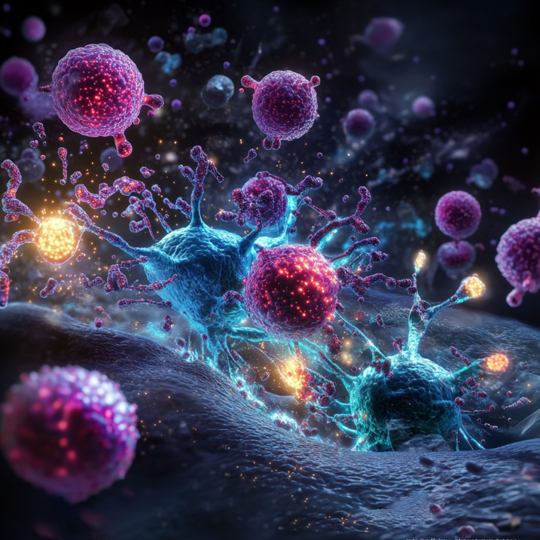 dden Layer of Immunity—Discovered! 🔬
dden Layer of Immunity—Discovered! 🔬
For years, proteasomes were thought to be nothing more than cellular waste processors, breaking down proteins and presenting fragments to the immune system. But new research led by Prof. Yifat Merbl from the Weizmann Institute, in collaboration with Prof. Nissan Yissachar at BIU Life Sciences & BINA shows they’re doing something far more exciting: actively defending our cells against bacterial infections.
The team uncovered a previously unknown function of proteasomes—they generate natural antimicrobial peptides that directly attack bacteria. These tiny protein fragments disrupt bacterial membranes, stopping infections before the immune system even steps in.
This discovery opens up incredible possibilities:
✅ A deeper understanding of how our cells fight infections on their own.
✅ A potential new source of natural antibiotics, which could help combat drug-resistant bacteria.
✅ A fresh look at proteasomes, not just as protein recyclers but as key players in immune defense.
With antibiotic resistance becoming a global crisis, breakthroughs like this could reshape how we fight infections. Huge congratulations to Prof. Yifat Merbl, Prof. Nissan Yissachar, and the team for shedding light on a whole new dimension of immunity!
#Immunology #Biotechnology #AntibioticResistance #Proteasomes #Innovation
https://doi.org/10.1038/s41586-025-08615-w
 🩺 A New Era in Personalized Cancer Treatment
🩺 A New Era in Personalized Cancer Treatment
Cancer therapies have come a long way, but one major challenge remains: predicting whether a drug will actually work for a specific patient. Doron Gerber and his team have developed OncoFlow, a microfluidic platform that tests how an individual’s tumor cells respond to different treatments—before those treatments are prescribed.
Rather than relying solely on genetic profiling, this approach provides a real-time, functional readout of drug sensitivity, helping oncologists make faster, more informed decisions while sparing patients from ineffective treatments and unnecessary side effects.
🔬 Why this is a game-changer:
✔️ Provides personalized treatment guidance based on actual tumor behavior
✔️ Avoids the trial-and-error of cancer therapy
✔️ Accelerates the move toward truly functional precision medicine
This technology could significantly reshape how cancer treatments are tailored, ensuring that the right drug reaches the right patient at the right time. Exciting work by Doron Gerber and his team—looking forward to seeing its impact in the clinic!
#PersonalizedMedicine #Oncology #CancerResearch #MedicalInnovation
https://doi.org/10.1016/j.nbt.2025.03.002
What 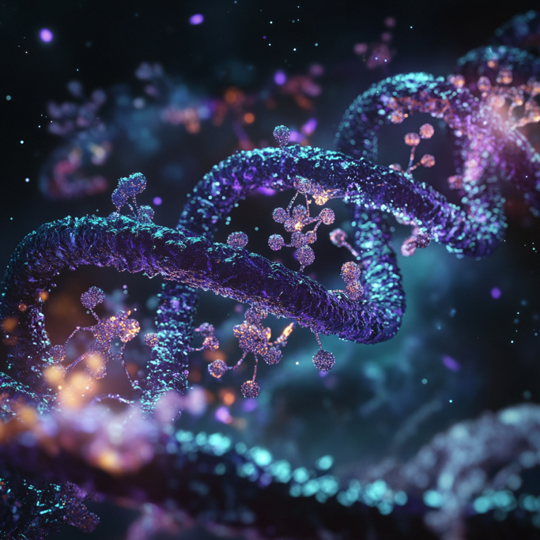 happens inside a single edited cell matters - and now we can finally see it.
happens inside a single edited cell matters - and now we can finally see it.
In an innovative new study, Prof. Ayal Hendel, Nechama Kalter, and Dr. Michael Rosenberg, in collaboration with Mission Bio team (CA, USA), used single-cell DNA sequencing to map CRISPR editing outcomes in stunning detail. They tracked which edits happened in which cells, detected rare off-target events, and even linked genetic changes to protein expression - all in one assay.
This level of resolution is a major step forward for gene and cell therapies. It brings us closer to treatments that aren't just powerful, but also safe, consistent, and truly personalized.
It’s not just about making edits anymore. It’s about understanding their full impact - cell by cell.
Huge congrats to Prof. Hendel and everyone involved in this work.
#GeneTherapy #CRISPR #SingleCellSequencing #PrecisionMedicine #Innovation
https://doi.org/10.1016/j.omtm.2025.101449
Big news from the world of smart textiles 🧵⚡
the world of smart textiles 🧵⚡
Prof. Giuseppe Rosace and Dr. Valentina Trovato, together with Prof. Valerio Re and Dr. Paolo Lazzaroni (two research teams from the University of Bergamo), in collaboration with Prof. Gilbert Daniel Nessim, Dr. Rajashree Konar & Dr. Eti Teblum, have developed a new type of cotton fabric coated with 2D-layered tungsten diselenide (2H-WSe₂) - and it does more than just look good. It can actually sense changes in humidity and temperature, all while staying soft, flexible, and wearable.
What’s exciting here is the combination of comfort and function. This fabric doesn’t just carry sensors — it is the sensor. That opens up new possibilities for wearable tech in areas like health monitoring, environmental sensing, and even climate-adaptive clothing.
A big step forward - and one with real potential to change how we interact with our environment.
Huge congratulations to Dr. Valentina Trovato, Prof. Nessim, and both entire research teams at the University of Bergamo and BINA. Can’t wait to see where this leads.
#SmartTextiles #WearableTech #2Dmaterials #Innovation #MaterialsScience
https://doi.org/10.3390/polym17060752
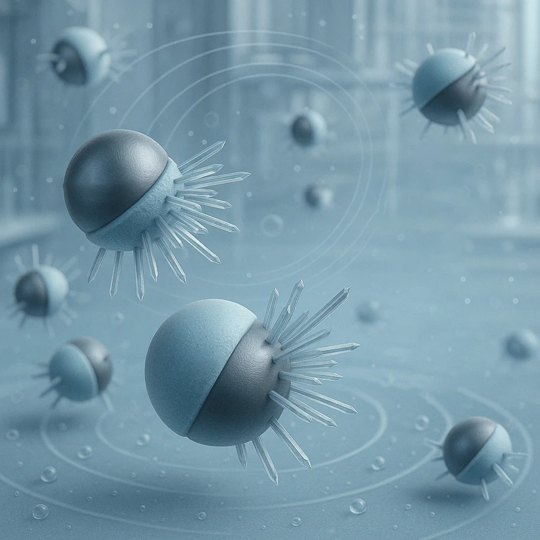
🧲✨ Magnetic particles with a twist—literally.
Kudos to Prof. Amos Sharoni, Prof. Yitzhak Mastai, and their team—especially PhD student Yarden Ben Moshe—for pioneering the development of chiral Janus magnetic polymeric particles capable of distinguishing between molecular mirror images, known as enantiomers.
In pharmaceuticals, agriculture, and many other industries, separating enantiomers is vital: one version of a molecule might heal, while its mirror image could be ineffective, or even harmful. Yet efficient separation has long been a major challenge.
Enter this novel approach: by combining ferromagnetic coatings with chiral polymer beads, the team directs crystallization toward a specific enantiomer. Their results showed a high enantiomeric excess, compelling proof of concept.
🌍 Why does it matter? Because magnetically assisted, scalable separation could revolutionize how we produce essential compounds, making the process cleaner, greener, and far more efficient.
#Chirality #MaterialsScience #Nanotech #GreenChemistry #BarIlanUniversity
https://doi.org/10.1021/acsomega.4c11154
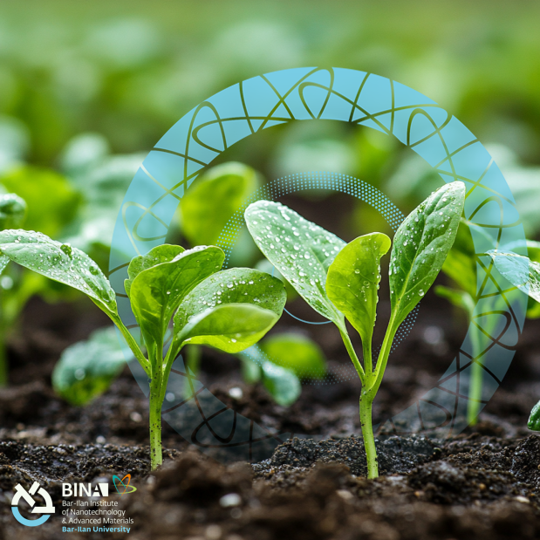 🌱 A Game-Changer for Sustainable Farming 🌱
🌱 A Game-Changer for Sustainable Farming 🌱
In a recent study, Prof. Aharon Gedanken and his team at Bar-Ilan University have discovered that nitrogen-doped carbon dots (NCDs)—tiny nanoparticles made from betel leaves—can dramatically enhance plant growth while reducing the need for fertilizers.
In their study, lettuce and pepper plants irrigated with NCDs showed higher fresh and dry weights, greater fruit yield, and improved root development—all with minimal environmental impact! 🍃
This innovation could transform agriculture by:
🌍 Producing more food with fewer resources
🍃 Providing an eco-friendly alternative to chemical fertilizers
☀️ Boosting photosynthesis and nutrient uptake for healthier crops
At a time when food security and sustainability are critical, solutions like this pave the way for smarter, more efficient farming.
Could nanotechnology be the key to feeding a growing world?
For more insights, check out the publication-
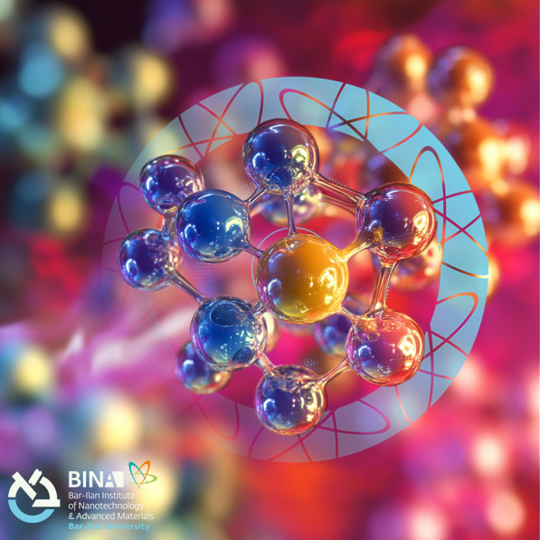
Some discoveries don’t just add to our understanding—they redefine it.
A new study by Prof. Eli Sloutskin and his team reveals that oil droplets densely cloaked with tiny microparticles—known as Pickering emulsions—can be precisely manipulated by temperature to undergo dramatic, non-random shape transformations.
Even when their surfaces are heavily covered by thousands of particles acting as rigid inclusions, the droplets reliably buckle into complex and well-defined forms, self-dividing or forming tail-like protrusions under
certain conditions.
This breakthrough not only challenges traditional views on particle-laden droplet behavior but also opens exciting avenues for innovations in targeted microcargo delivery, smart material design, and advanced colloidal self-assembly.
For more insights, check out the publication: https://doi.org/10.1021/acsnano.4c13476
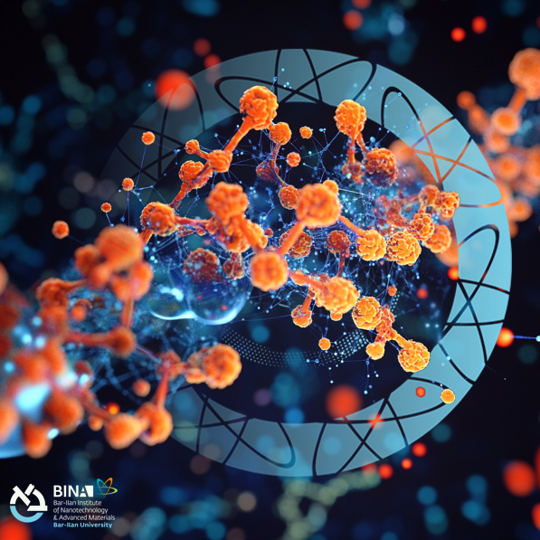 🧪 Revolutionizing Enzyme Docking: A New Era in Drug Discovery 🧪
🧪 Revolutionizing Enzyme Docking: A New Era in Drug Discovery 🧪
Predicting how enzymes interact with small molecules is a major challenge in drug development and biotechnology. Prof. Dan T. Major, Prof. Wonpil Im and their team have introduced CHARMM-GUI EnzyDocker, a web-based tool that makes enzyme docking more accessible, efficient, and precise.
Why does this matter?
🔬 It helps researchers model enzyme-ligand interactions across multiple reactive states
💊 It improves the accuracy of drug design and enzyme-based catalysis
🖥️ It simplifies complex docking simulations, reducing the need for manual setup
The tool has already been used to study SARS-CoV-2 proteins, enzyme inhibitors, and biochemical reaction pathways. By making advanced docking simulations more intuitive, EnzyDocker is paving the way for breakthroughs in medicine and materials science.
Could this new approach change the way we design life-saving drugs?
For more insight, visit: https://doi.org/10.1021/acs.jctc.4c01691
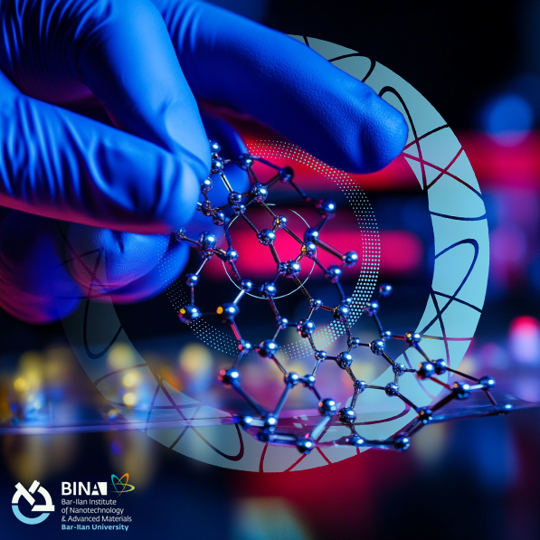 🔬A fascinating breakthrough in energy storage and electrocatalysis!
🔬A fascinating breakthrough in energy storage and electrocatalysis!
Prof. Gilbert Daniel Nessim and his team have developed a photoactive manganese-based metallopolymer that could change the way we store and utilize energy. This innovative material enhances supercapacitor performance, offering both high power density and long-term stability while also displaying stable photocurrent responses toward photo-assisted charging.
Why is this significant?
🔋 Improved supercapacitor efficiency due to the presence of dual redox sites.
⚡ Harnessing light for energy storage opens new possibilities for renewable technology.
🌍This metallopolymer can perform oxygen reduction reactions and exhibit supercapacitance, demonstrating multifunctional properties for a wide range of industrial applications, from energy storage and light harvesting to energy conversion
This discovery brings us closer to smarter, more sustainable energy solutions. What potential applications come to your mind?
For more information, visit https://doi.org/10.1021/acsaem.4c02343
 🚀 Shaping Graphene at the Atomic Level 🚀
🚀 Shaping Graphene at the Atomic Level 🚀
A groundbreaking discovery by Dr. Olga Girshevitz and Nahum Shabi, in collaboration with Prof. Issai Shlimak at Bar-Ilan University, reveals a surprising truth about graphene: it’s not the ion’s mass but its velocity that determines defect formation.
By precisely controlling ion speed, researchers can now fine-tune graphene’s structure, unlocking new ways to enhance its properties. This breakthrough paves the way for:
💪 Stronger, more versatile nanomaterials
🖥️ High-performance electronics with tailored characteristics
🔋 New possibilities in energy storage and filtration
Understanding and manipulating defects at this level opens new frontiers in materials design with unprecedented precision.
Learn more about our research at
https://www.sciencedirect.com/science/article/pii/S246802302500135X
Exciting Research Alert!
Prof. Dror Fixler, in collaboration with Prof. Mordechai Deutsch (Physics Department, BIU) that passed away few months ago and Dr. Zeev Schiffer (Elbit Systems), has published exciting research on Addressable Nanoliter Containers (ANLCs) in Nanomaterials. These ANLCs present a novel solution for cryopreserving single sperm cells, effectively tackling the issue of increased sperm cell mortality caused by water diffusion into the oil phase, which elevates salt concentration. The team successfully minimized this diffusion by saturating the oil with water, achieving a remarkable 100% survival rate for sperm cells in nanoliter-scale containers. Optical simulations revealed that cylindrical containers with flat bottoms reduce light scattering, enhancing the device's performance. Tested in an IVF lab, this innovative tool shows significant promise for housing and selecting individual sperm cells for IVF, utilizing interferometric indicators for precise characterization. For more details, explore their publication: https://doi.org/10.3390/nano15030149
Exciting Research Alert!
Prof. Shlomo Margel and Prof. Ehud Banin have developed a novel, straightforward method for creating biodegradable hydrogels using polyvinyl alcohol (PVA) and polyvinyl pyrrolidone (PVP) for medical applications. Their findings, recently published in Gels, highlight these hydrogels' unique combination of water absorbency, biocompatibility, and biodegradability.
Key Highlights:
Enhanced Water Absorbency & Mechanical Properties: Incorporating PVP into PVA significantly boosts these features.
Controlled Release of Hydrogen Peroxide (HP): Ideal for hygiene products and medical uses like wound healing.
Improved Water Resistance: Achieved through freeze-thaw cycles and chemical crosslinking with trisodium trimetaphosphate (STMP).
Broad Applications: Environmentally friendly bio-based polymer blends for medical and industrial products.
The hydrogels were characterized using FTIR, E-SEM, and water-swelling tests. Their antibacterial activity was tested on four medically relevant bacteria, demonstrating effective HP controlled release.
These findings pave the way for further in vivo investigations into controlled HP release systems for enhanced wound-healing outcomes. For more insights, visit https://doi.org/10.3390/gels11010031
Exciting news from Prof. Aharon Gedanken’s team!
They have developed an advanced ultrasonic synthesis method for cellulose nanocrystals (CNCs) and applied them as coatings on flexible substrates like cotton (CC-1) and membrane (CM-1). Their findings, recently published in Polymers, highlight the potential of CNCs in creating antibiofilm surfaces with strong antimicrobial properties.
Key highlights:
CNCs exhibit excellent water repellency with a contact angle of 148° on membranes
CNC-coated substrates show increased reactive oxygen species (ROS) generation, enhanced surface hydrophobicity, and effective suppression of both drug-sensitive and susceptible bacterial strains
Uncoated substrates, in contrast, show 100% bacterial growth
CNC-coated substrates significantly reduce biofilm mass across all tested bacterial strains
The study suggests that ROS generation and electrostatic repulsion between CNCs and bacterial membranes disrupt mature biofilms, making CNC-coated substrates a promising platform for infectious disease management. For more details, visit: https://doi.org/10.3390/polym17020154
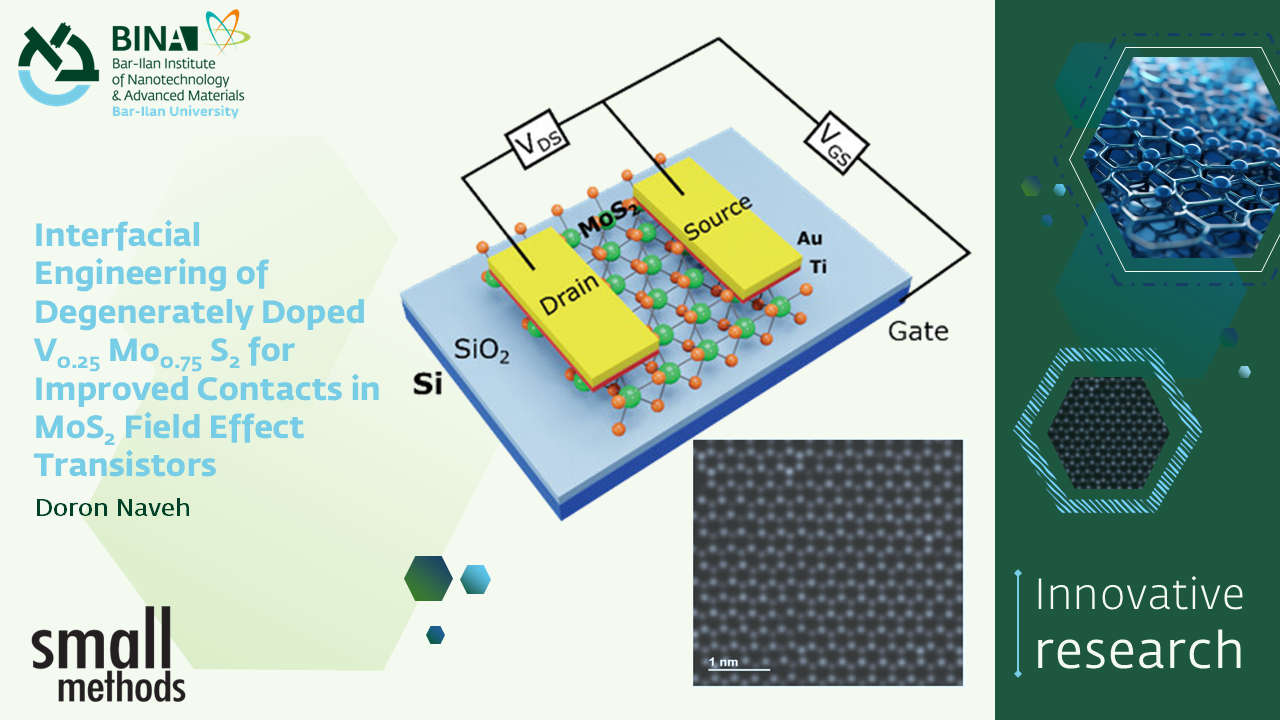 Breaking barriers with cutting-edge materials!
Breaking barriers with cutting-edge materials!
Imagine electronic devices that are faster, more efficient, and powered by the tiniest building blocks—this is where 2D materials like MoS₂ come in.
The latest research from Prof. Doron Naveh's lab tackles a major challenge in making these materials work for real-world electronics: the tricky interface between metal contacts and the material itself.
Their solution? A clever upgrade using a thin layer of V₀.₂₅Mo₀.₇₅S₂, which acts as a "bridge" to reduce the potential barrier.
Their innovation:
✔️ Halved the resistance at the contact points
✔️ Made the technology more scalable for industrial use
✔️ Paved the way for smaller, more efficient electronics
This work brings us one step closer to next-generation devices that could transform everything from smartphones to futuristic sensors.
Learn more about this exciting research: https://onlinelibrary.wiley.com/doi/10.1002/smtd.202401938?trk=feed-detail_main-feed-card_feed-article-content
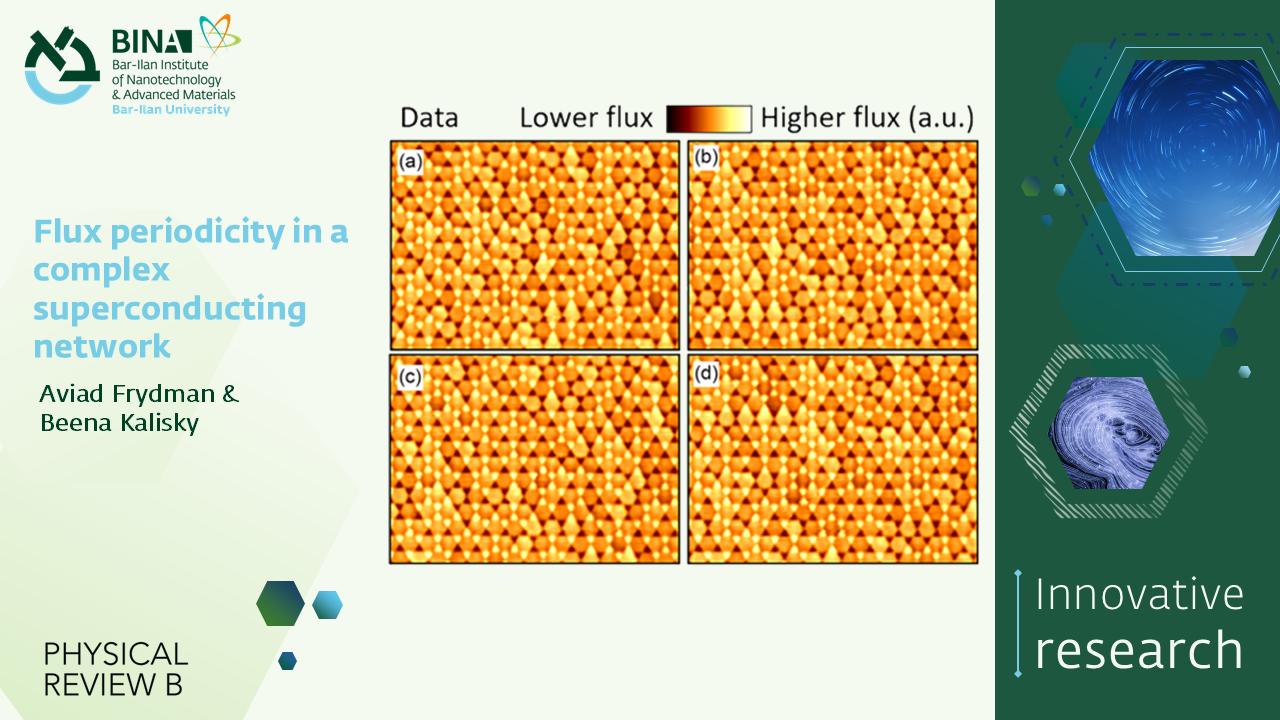 🌟 "Flux Periodicity in a Complex Superconducting Network" explores the fascinating phenomenon of flux quantization in superconductors! 🧲✨ When magnetic flux passes through a superconducting network, the system's properties oscillate periodically 🔄—a behavior tied to the quantum nature of superconductivity. 🌀 The research dives into how this periodicity emerges in intricate, interconnected superconducting structures, shedding light on the interplay between geometry, flux, and quantum mechanics. 🧑🔬⚡ Perfect for those passionate about cutting-edge physics and quantum materials! 🚀💡
🌟 "Flux Periodicity in a Complex Superconducting Network" explores the fascinating phenomenon of flux quantization in superconductors! 🧲✨ When magnetic flux passes through a superconducting network, the system's properties oscillate periodically 🔄—a behavior tied to the quantum nature of superconductivity. 🌀 The research dives into how this periodicity emerges in intricate, interconnected superconducting structures, shedding light on the interplay between geometry, flux, and quantum mechanics. 🧑🔬⚡ Perfect for those passionate about cutting-edge physics and quantum materials! 🚀💡
🔗 Read more: https://journals.aps.org/prb/abstract/10.1103/PhysRevB.110.214514
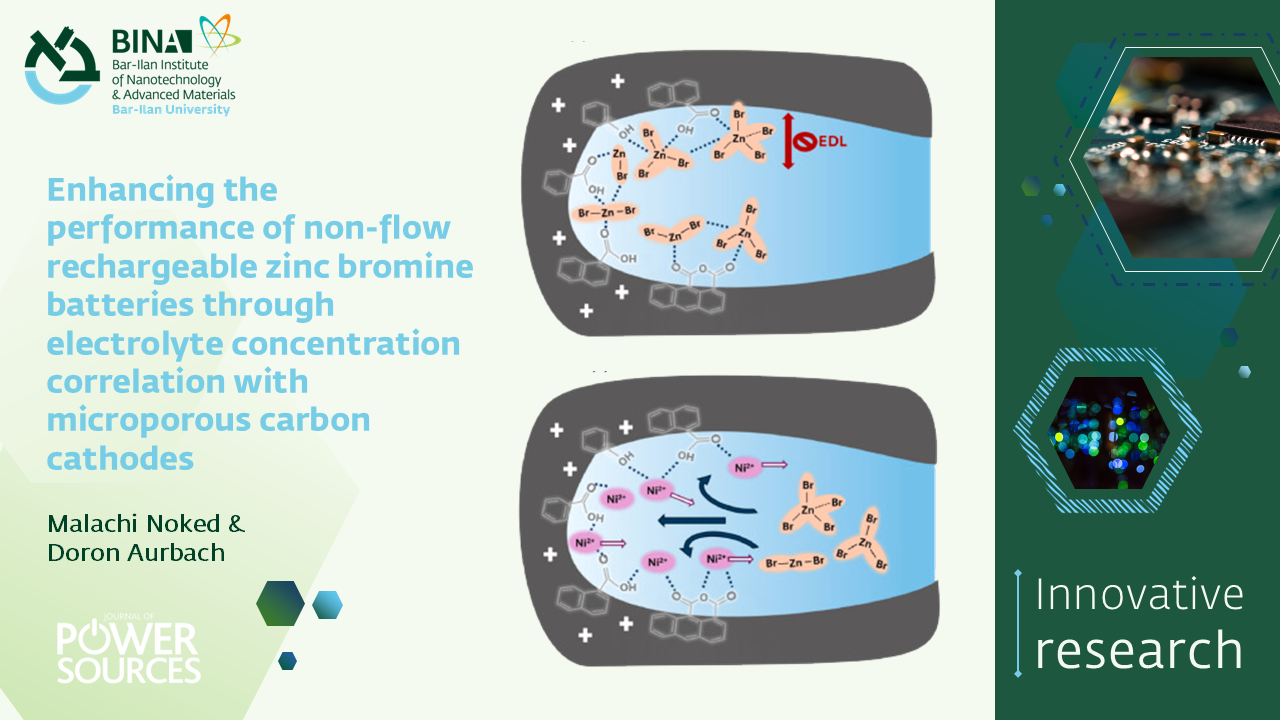 Revolutionizing Energy Storage with Zinc-Bromine Batteries!
Revolutionizing Energy Storage with Zinc-Bromine Batteries!
As the world transitions to renewable energy, finding safe, cost-effective, and scalable storage solutions is more critical than ever.
The latest research from Prof. Malachi Noked and Prof. Doron Aurbach labs explores the exciting potential of static zinc-bromine batteries (ZBBs)—a promising alternative to traditional flow batteries.
By fine-tuning the interaction between microporous carbon cathodes and zinc-bromine electrolytes, they achieved:
✔️ Record-high efficiency (>96%)
✔️ Enhanced energy density without additives
✔️ Insights into electrolyte and electrode design for optimal performance
This breakthrough highlights the importance of tailoring materials at the nano-level to create compact, safe, and efficient energy storage systems. Such innovations are vital for a sustainable energy future!
Read more in their paper: https://www.sciencedirect.com/science/article/pii/S0378775324015453
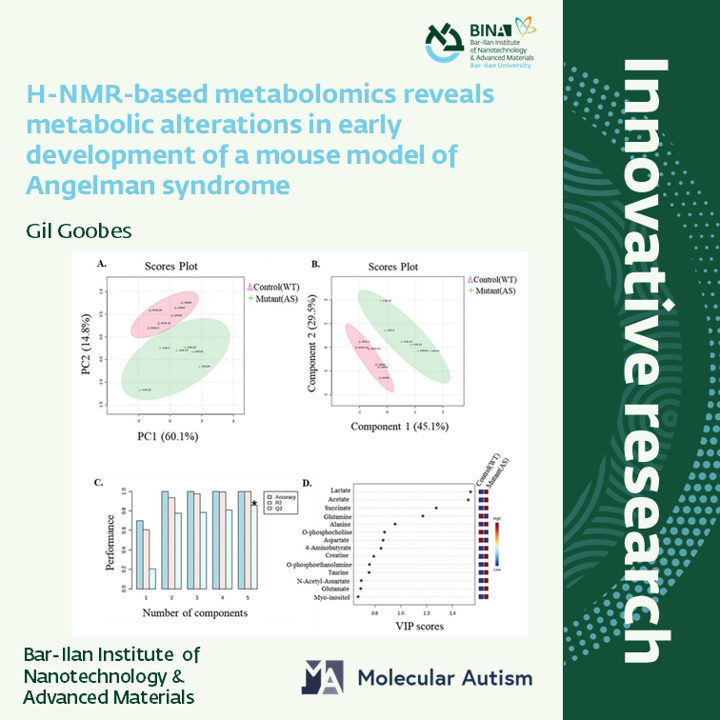 Excited to share that Prof. Gil Goobes and his colleague, Prof. Hanoch Kaphzan, from the University of Haifa, have published a groundbreaking study in Molecular Autism. Their research delves into metabolic changes during early development in a mouse model of Angelman Syndrome (AS), a neurodevelopmental disorder linked to UBE3A gene dysfunction. Using 1H-NMR-based metabolomics, they analyzed brain tissue from embryonic mice (E16.5) and found significant metabolic differences between AS and wild-type (WT) brains. Notably, they observed elevated metabolites like acetate, lactate, and succinate levels, which are tied to glycolytic and pyruvate metabolism pathways. The study highlights that UBE3A dysfunction affects bioenergy metabolism in the AS brain during embryonic development, potentially leading to increased oxidative stress and apoptosis in neural precursor cells. While the study identified 14 metabolites, it opens the door for future research to explore additional unknown metabolites and brain region-specific analyses. It also underscores the unique role of NMR spectroscopy at accurately profiling metabolic pathways for many physiological in disease and therapy. For more insights, visit https://lnkd.in/d-aKiD_u
Excited to share that Prof. Gil Goobes and his colleague, Prof. Hanoch Kaphzan, from the University of Haifa, have published a groundbreaking study in Molecular Autism. Their research delves into metabolic changes during early development in a mouse model of Angelman Syndrome (AS), a neurodevelopmental disorder linked to UBE3A gene dysfunction. Using 1H-NMR-based metabolomics, they analyzed brain tissue from embryonic mice (E16.5) and found significant metabolic differences between AS and wild-type (WT) brains. Notably, they observed elevated metabolites like acetate, lactate, and succinate levels, which are tied to glycolytic and pyruvate metabolism pathways. The study highlights that UBE3A dysfunction affects bioenergy metabolism in the AS brain during embryonic development, potentially leading to increased oxidative stress and apoptosis in neural precursor cells. While the study identified 14 metabolites, it opens the door for future research to explore additional unknown metabolites and brain region-specific analyses. It also underscores the unique role of NMR spectroscopy at accurately profiling metabolic pathways for many physiological in disease and therapy. For more insights, visit https://lnkd.in/d-aKiD_u
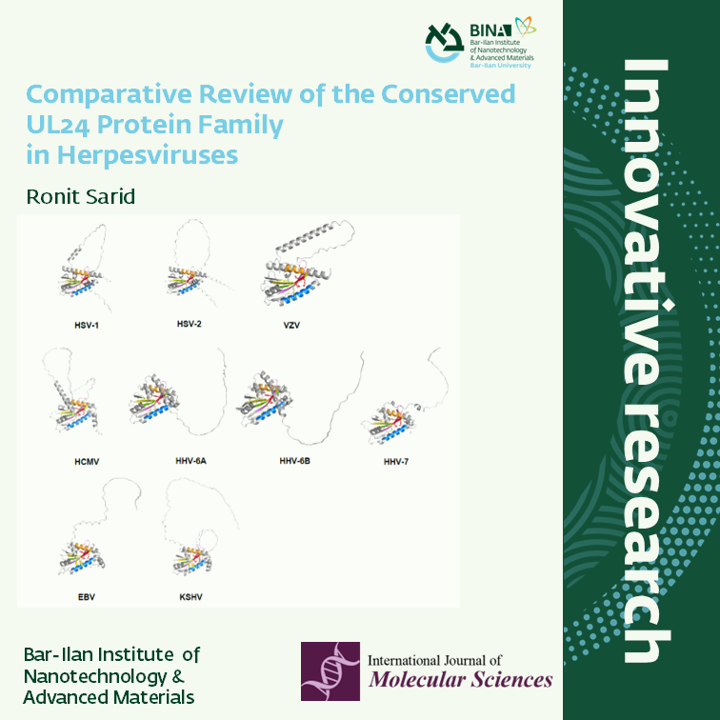 Prof. Ronit Sarid and her PhD student, Odelia Orbaum-Harel, recently published a comprehensive review paper on the UL24 protein family, which is conserved across all subfamilies of Orthoherpesviridae. This family of proteins plays crucial roles in viral replication, host-virus interactions, and pathogenesis. Understanding the molecular mechanisms and interactions of UL24 proteins is essential for unraveling the complex dynamics between herpesviruses and their hosts. This review offers a detailed comparative overview of current knowledge on UL24 family members, covering their conservation, expression patterns, cellular localization, and functional roles during viral infection. This work highlights the significance of UL24 proteins in herpesvirus biology and their potential functions, paving the way for future research in this field. For more insights, check out the review https://lnkd.in/eBrVApgJ
Prof. Ronit Sarid and her PhD student, Odelia Orbaum-Harel, recently published a comprehensive review paper on the UL24 protein family, which is conserved across all subfamilies of Orthoherpesviridae. This family of proteins plays crucial roles in viral replication, host-virus interactions, and pathogenesis. Understanding the molecular mechanisms and interactions of UL24 proteins is essential for unraveling the complex dynamics between herpesviruses and their hosts. This review offers a detailed comparative overview of current knowledge on UL24 family members, covering their conservation, expression patterns, cellular localization, and functional roles during viral infection. This work highlights the significance of UL24 proteins in herpesvirus biology and their potential functions, paving the way for future research in this field. For more insights, check out the review https://lnkd.in/eBrVApgJ
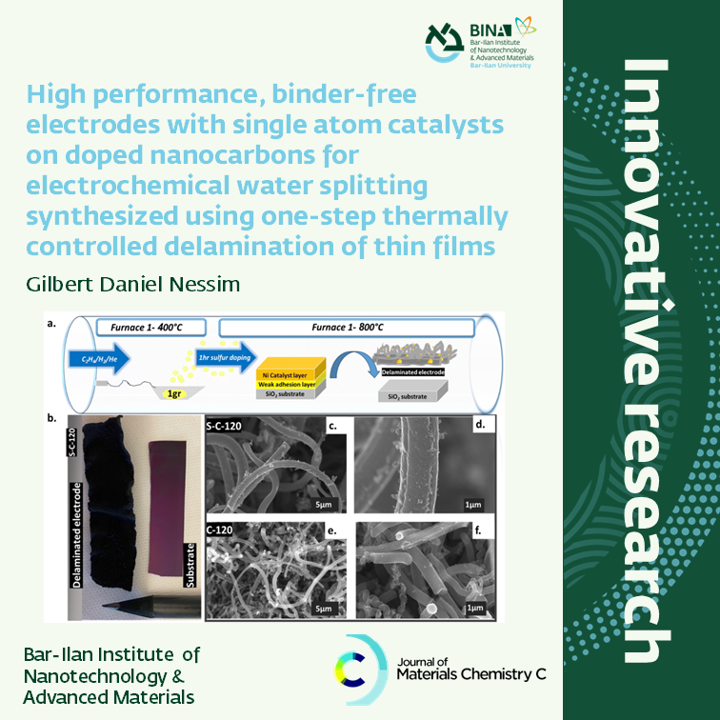 Prof. Gilbert Daniel Nessim and his team have published their exciting research on high-performance catalysts for electrochemical water splitting in the Journal of Materials Chemistry A. This work is a significant step towards efficient and sustainable hydrogen production.
Prof. Gilbert Daniel Nessim and his team have published their exciting research on high-performance catalysts for electrochemical water splitting in the Journal of Materials Chemistry A. This work is a significant step towards efficient and sustainable hydrogen production.
Their innovative one-step chemical vapor deposition (CVD) synthesis produces freestanding electrodes with nickel single-atom catalysts (SACs) on sulfur-doped carbon nanofibers (CNFs), termed SACs@nanocarbon. This method simplifies the production process, which traditionally involves multiple lengthy and costly steps.
Key highlights:
- Exceptional performance in oxygen evolution reaction (OER) and hydrogen evolution reaction (HER)
- Over 20,000 cycles with minimal change in overpotential
- Low onset overpotentials: 305 mV at 10 mA cm−2 (OER) and 40 mV at 17 mA cm−2 (HER)
- Improved performance over cycling
This novel synthesis could pave the way for high-performance, non-platinum group metal electrodes in various electrocatalytic applications. Additionally, the temperature-controlled delamination technique used could lead to the synthesis of new materials. For more insights, visit https://lnkd.in/daREYB62
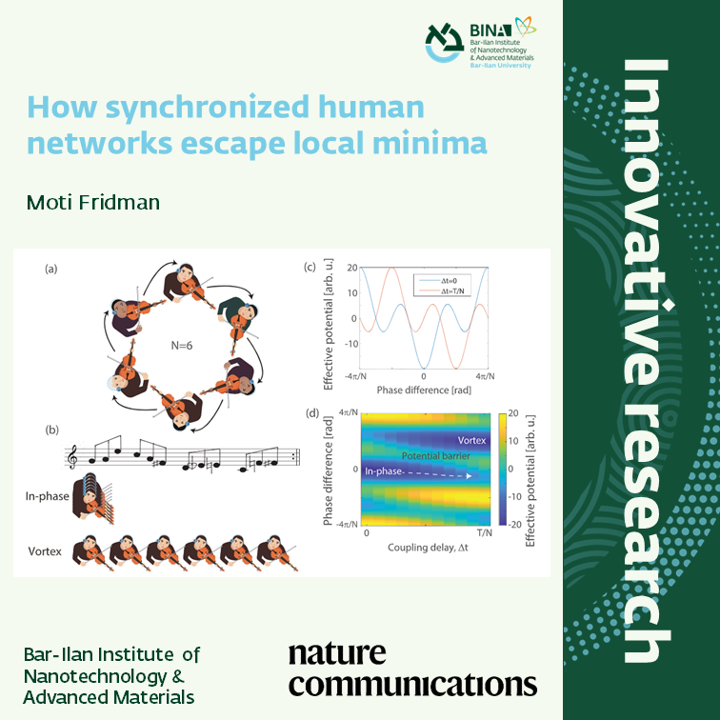 Prof. Moti Fridman and his team have made exciting discoveries in the dynamics of complex networks, specifically among violin players. Their recent study in Nature Communications sheds light on how human networks adapt and find new stable states amidst changing conditions like conflicts, climate changes, or disasters.
Prof. Moti Fridman and his team have made exciting discoveries in the dynamics of complex networks, specifically among violin players. Their recent study in Nature Communications sheds light on how human networks adapt and find new stable states amidst changing conditions like conflicts, climate changes, or disasters.
Unlike non-human networks, human networks can adjust coupling strength or tempo, making them more robust and resilient against perturbations. The team observed unique dynamics such as high-order vortex states, oscillation death, and amplitude death.
This research has far-reaching implications for politics, economics, pandemic control, decision-making, and predicting network dynamics with AI. To learn more, visit https://rdcu.be/dYzn2
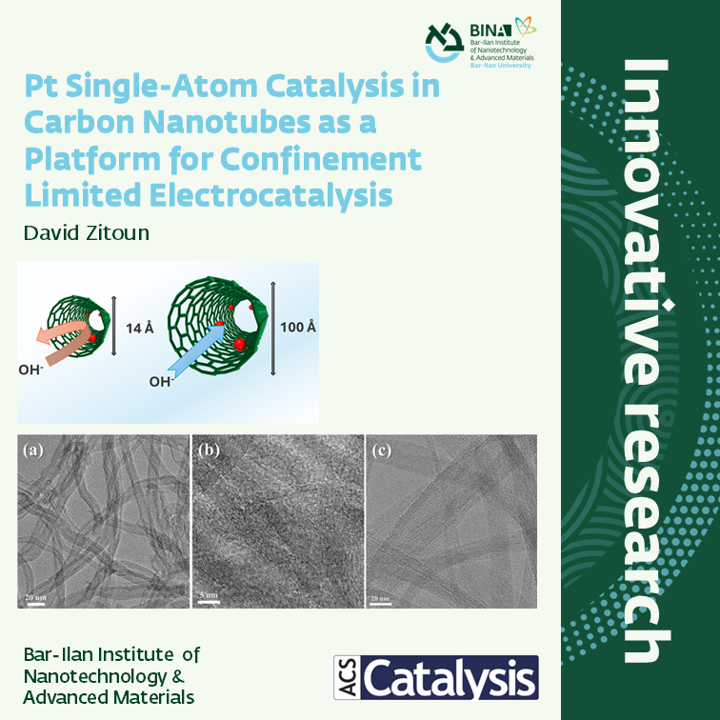 Prof. David Zitoun and his team have made significant progress in the field of electrocatalysis. Their recent work, published in ACS Catalysis, explores the effects of nanoconfinement on hydrogen oxidation reactions (HOR) in an alkaline medium. By designing a strongly confined system using carbon nanotubes (CNTs) with an inner diameter of 14 Å filled with a Pt single-atom catalyst (SAC), they demonstrated that nanoconfinement can slow down the kinetics of HOR, resulting in a higher overpotential compared to nonconfined Pt catalysts. Interestingly, this effect is less pronounced in CNTs with larger diameters and does not occur in acidic mediums. This exciting research highlights the impact of nanoconfinement on reaction kinetics and mass transport parameters, breaking the scaling laws of surface activity in electrocatalysis. Density functional theory calculations performed in collaboration with Prof. Ilya Grinberg (Chemistry Department) further explain the energy barrier for OH− to diffuse in CNTs. To dive deeper into their findings, check out the full publication https://lnkd.in/dJNuAcr8
Prof. David Zitoun and his team have made significant progress in the field of electrocatalysis. Their recent work, published in ACS Catalysis, explores the effects of nanoconfinement on hydrogen oxidation reactions (HOR) in an alkaline medium. By designing a strongly confined system using carbon nanotubes (CNTs) with an inner diameter of 14 Å filled with a Pt single-atom catalyst (SAC), they demonstrated that nanoconfinement can slow down the kinetics of HOR, resulting in a higher overpotential compared to nonconfined Pt catalysts. Interestingly, this effect is less pronounced in CNTs with larger diameters and does not occur in acidic mediums. This exciting research highlights the impact of nanoconfinement on reaction kinetics and mass transport parameters, breaking the scaling laws of surface activity in electrocatalysis. Density functional theory calculations performed in collaboration with Prof. Ilya Grinberg (Chemistry Department) further explain the energy barrier for OH− to diffuse in CNTs. To dive deeper into their findings, check out the full publication https://lnkd.in/dJNuAcr8
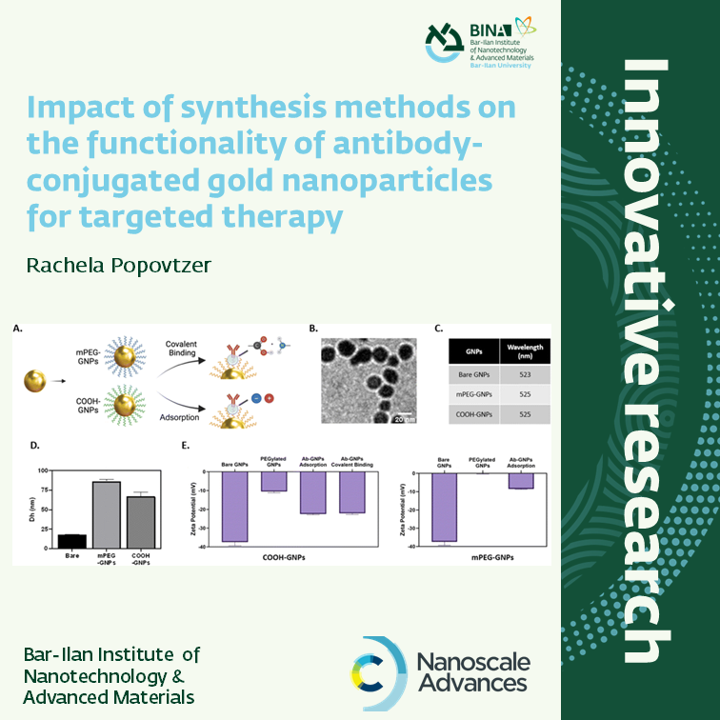 Prof. Rachela Popovtzer's team, led by Adi Anaki, has published research in Nanoscale Advances on how covalent binding and physical adsorption impact the anti-cancer functionality of antibody-coated gold nanoparticles (GNPs). Covalent binding, especially with higher antibody mass, significantly enhances cancer cell-killing. These findings emphasize the importance of synthesis methods in optimizing GNPs for cancer therapy. For more insights, visit https://lnkd.in/dRnZRx6B
Prof. Rachela Popovtzer's team, led by Adi Anaki, has published research in Nanoscale Advances on how covalent binding and physical adsorption impact the anti-cancer functionality of antibody-coated gold nanoparticles (GNPs). Covalent binding, especially with higher antibody mass, significantly enhances cancer cell-killing. These findings emphasize the importance of synthesis methods in optimizing GNPs for cancer therapy. For more insights, visit https://lnkd.in/dRnZRx6B
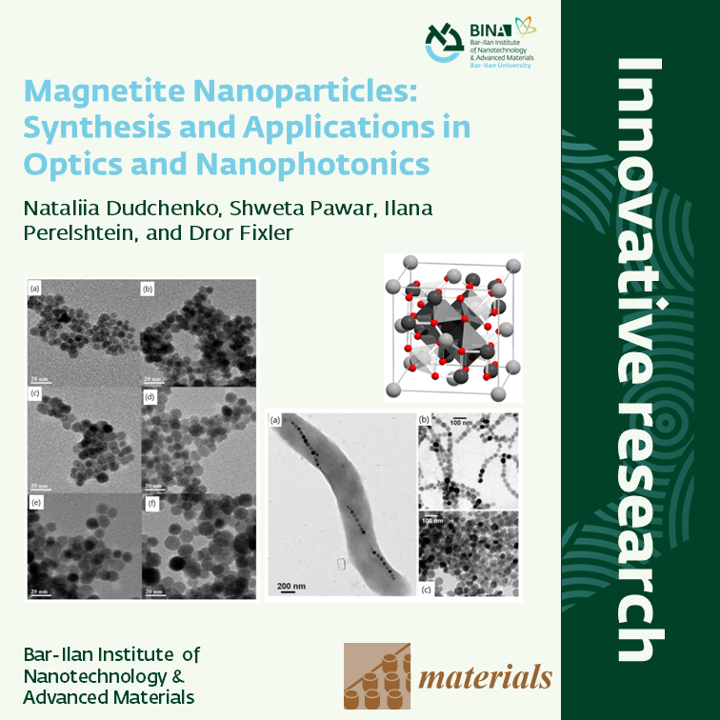 The BIMagnetite Nanoparticles: Synthesis and Applications in Optics and Nanophotonics team is thrilled to share that our review article, published in Materials, has been honored as an “Editor’s Choice Article” in the Special Issue on Optical and Photonic Materials. Authored by Nataliia Dudchenko, Shweta Pawar, Ilana Perelshtein, and Dror Fixler, this review is also a strong contender for the Materials 2025 Best Paper Award, recognized for its high views and citations among 2022 publications.
The BIMagnetite Nanoparticles: Synthesis and Applications in Optics and Nanophotonics team is thrilled to share that our review article, published in Materials, has been honored as an “Editor’s Choice Article” in the Special Issue on Optical and Photonic Materials. Authored by Nataliia Dudchenko, Shweta Pawar, Ilana Perelshtein, and Dror Fixler, this review is also a strong contender for the Materials 2025 Best Paper Award, recognized for its high views and citations among 2022 publications.
The article provides an in-depth exploration of nanomagnetite synthesis, properties, and a wide range of applications. These include photonic materials, organic light-emitting diodes (OLEDs), magnetic field sensors, “smart” windows, magnetic resonance imaging (MRI), and solar energy harvesting. Magnetite nanoparticles are at the forefront of progress in optics and nanophotonics, paving the way for groundbreaking innovations in sensing, imaging, and advanced photonic devices.
We invite you to support our nomination by viewing, downloading, citing, and sharing the article to help us win this prestigious award.
Please visit- https://lnkd.in/dAhe-qCG
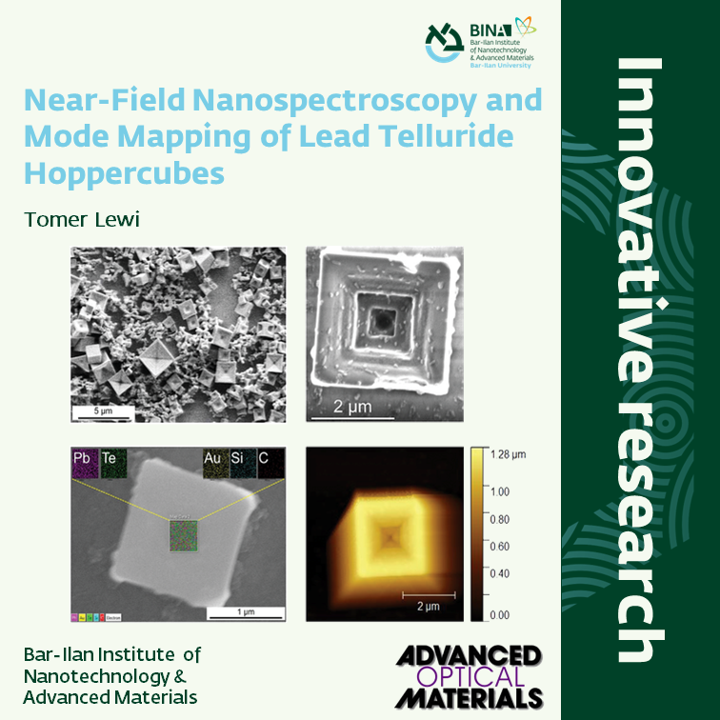 Dr. Tomer Lewi and his team have just published their exciting research on lead telluride Hoppercubes in Advanced Optical Materials. Chalcogenides are fascinating for nanophotonics and optoelectronics due to their high refractive indices, extreme thermo-optic coefficients, and excellent mid-infrared (MIR) transparency. In this study, Prof. Lewi’s team lead by Dr. Sukanta Nandi, synthesized PbTe hoppercubes (HC, face-open box cubes) and explored their MIR resonant characteristics.
Dr. Tomer Lewi and his team have just published their exciting research on lead telluride Hoppercubes in Advanced Optical Materials. Chalcogenides are fascinating for nanophotonics and optoelectronics due to their high refractive indices, extreme thermo-optic coefficients, and excellent mid-infrared (MIR) transparency. In this study, Prof. Lewi’s team lead by Dr. Sukanta Nandi, synthesized PbTe hoppercubes (HC, face-open box cubes) and explored their MIR resonant characteristics.
Key findings include: 🔬 Deep-subwavelength light localization with a spectral response dominated by fundamental and multiple high-order Mie-resonant modes. 🖼️ Nanoimaging mapping using scattering-type scanning near-field optical microscopy (s-SNOM) revealed that scattering at the center is reduced by more than five times compared to the edges. 📊 2D-Hyperspectral scans provided detailed information on local amplitude and phase-resolved near-fields, including higher-order modes with Q-factors close to 100.
This research has significant implications for quantum sensing, IR photodetection, non-linear generation, and ultra-compact high-Q metaphotonics.
For more insights, check out the full publication: https://lnkd.in/di2i7jhv
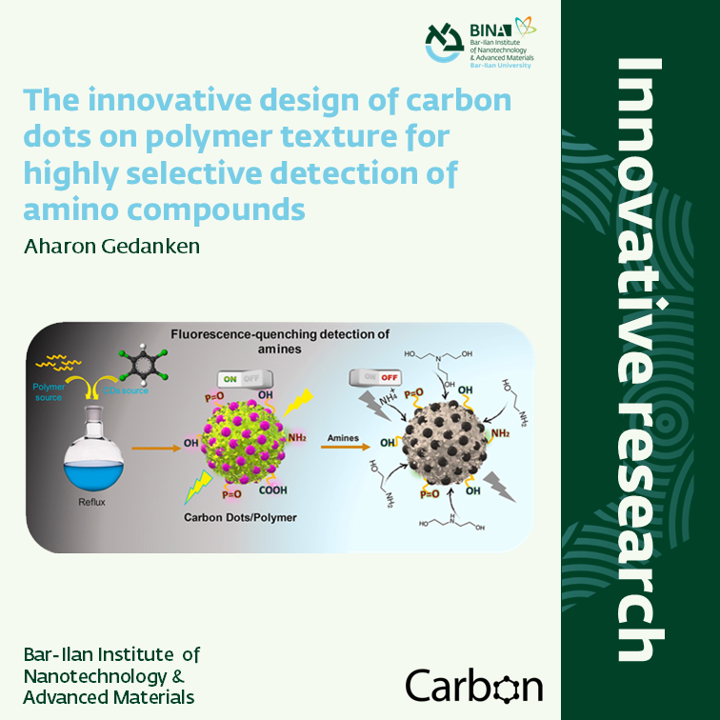 Prof. Aharon Gedanken’s team, in collaboration with colleagues from the Czech Republic, has just published exciting research on polymer-supported fluorescent carbon dots (P-CDs) in Carbon. Volatile organic compounds (VOCs) pose significant environmental and health risks due to their toxicity. Detecting these compounds is crucial but challenging due to their low concentrations and unreactive nature. To tackle this, the team developed polymer-supported carbon dots (CDs) using a simple reflux method. These P-CDs are highly stable, and their fluorescence is quenched by VOC analytes such as ethanolamine, diethanolamine, triethanolamine, and ammonia. The polymer component enhances their photophysical and chemical stability, making them ideal for sensing in complex environments. Key highlights of the P-CDs are high selectivity for amines, fast response times, exceptional stability, and user-friendly detection with minimal sample preparation. This innovative design holds promise for various applications, including monitoring prohibited chemical transport and post-toxic analysis. Read the full paper here: https://lnkd.in/dXrKEguD
Prof. Aharon Gedanken’s team, in collaboration with colleagues from the Czech Republic, has just published exciting research on polymer-supported fluorescent carbon dots (P-CDs) in Carbon. Volatile organic compounds (VOCs) pose significant environmental and health risks due to their toxicity. Detecting these compounds is crucial but challenging due to their low concentrations and unreactive nature. To tackle this, the team developed polymer-supported carbon dots (CDs) using a simple reflux method. These P-CDs are highly stable, and their fluorescence is quenched by VOC analytes such as ethanolamine, diethanolamine, triethanolamine, and ammonia. The polymer component enhances their photophysical and chemical stability, making them ideal for sensing in complex environments. Key highlights of the P-CDs are high selectivity for amines, fast response times, exceptional stability, and user-friendly detection with minimal sample preparation. This innovative design holds promise for various applications, including monitoring prohibited chemical transport and post-toxic analysis. Read the full paper here: https://lnkd.in/dXrKEguD
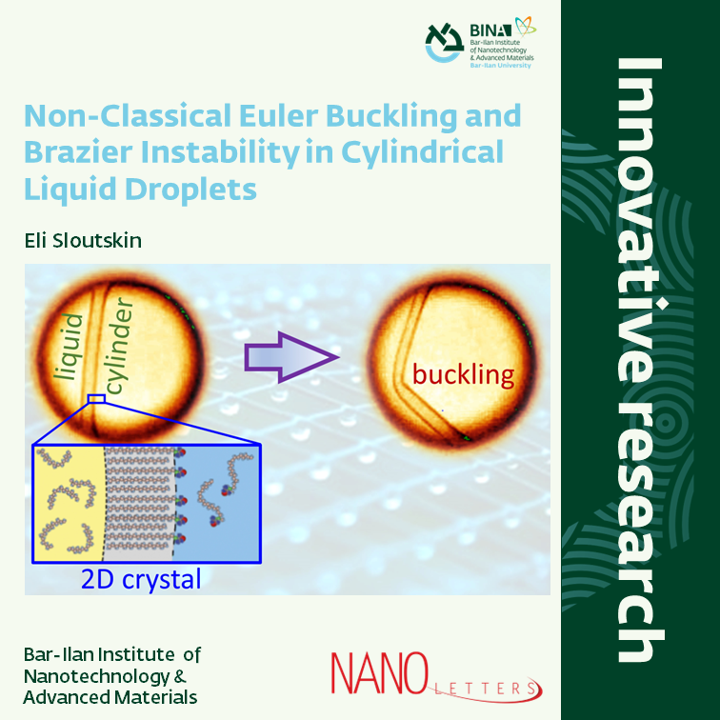 Exactly 250 years ago, Leonhard Euler discovered the critical conditions for the buckling of a solid column under longitudinal load. This instability phenomenon is well known to civil engineers and anyone who has ever tried to apply longitudinal force to a thin rod: for example, if a straight hammer blow on a nail caused it to bend instead of driving it directly into the wall, it happened due to Euler's instability. Although Euler's original calculation referred to a solid cylindrical rod, applying longitudinal force to a thin cylindrical tube, such as a drinking straw or a syringe needle, can similarly cause it to bend. However, in addition to the classical Euler instability, other scenarios, such as walls’ buckling or wrinkling, are possible as well.
Exactly 250 years ago, Leonhard Euler discovered the critical conditions for the buckling of a solid column under longitudinal load. This instability phenomenon is well known to civil engineers and anyone who has ever tried to apply longitudinal force to a thin rod: for example, if a straight hammer blow on a nail caused it to bend instead of driving it directly into the wall, it happened due to Euler's instability. Although Euler's original calculation referred to a solid cylindrical rod, applying longitudinal force to a thin cylindrical tube, such as a drinking straw or a syringe needle, can similarly cause it to bend. However, in addition to the classical Euler instability, other scenarios, such as walls’ buckling or wrinkling, are possible as well.
Although these phenomena have been studied for centuries, there are still some open questions remaining. Arguably, the most important question is: do the same laws apply at the nanometric scale? As technological progress depends greatly on the miniaturization of engineering and electronic systems, the questions of mechanical stability at the nanometric scale have great practical importance.
In groundbreaking research by Prof. Eli Sloutskin and his team, in collaboration with the group of Prof. Daeyeon Lee from the University of Pennsylvania in the USA, the conditions for Euler buckling of cylindrical tubes with walls made of a single layer of molecules were uncovered. In this study, the researchers used liquid droplets, the surfaces of which were covered by a temperature-controlled, self-assembled single-molecular-layer crystal. As a result of this crystal’s formation, the droplets transform into a cylindrical shape, while the body of the droplet remains liquid. The internal liquid medium of the droplet does not have elastic properties, so that applying a longitudinal pressure on the droplet directly tests the elastic properties of the two-dimensional molecular layer covering the surface of the droplet.
Strikingly, these experiments demonstrate that the classical theory of elasticity, developed for continuous bulk matter, does not hold for two-dimensional crystals. For example, in stark contrast to classical elasticity, in these crystals, the bending modulus is not dependent on the Young's modulus. The ability to control these two moduli independently opens new possibilities in nanotechnology that do not exist in regular bulk matter. For more insights, please visit https://doi.org/10.1021/acs.nanolett.4c02075
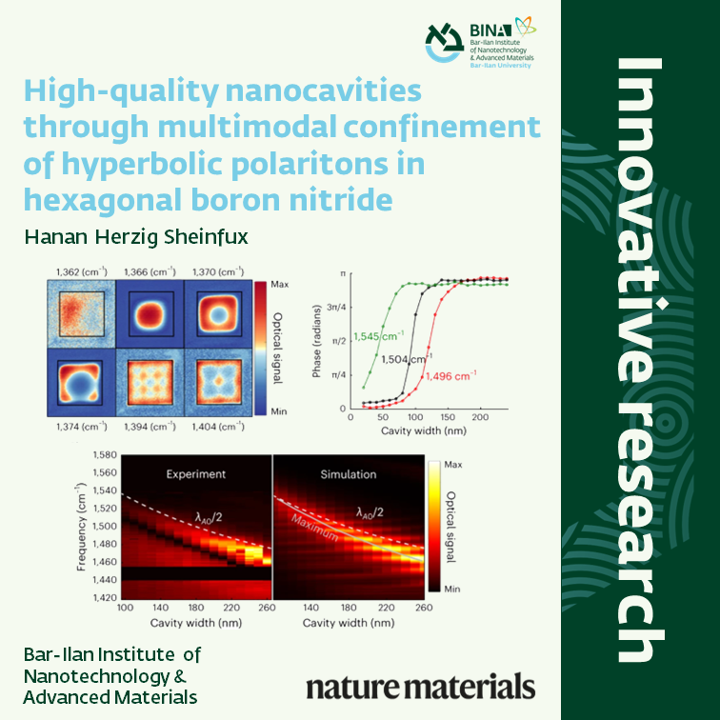 Dr. Hanan Sheinfux and his colleagues have made a significant breakthrough in light compression and polariton manipulation which was recently published in the esteemed Nature Materials. Compressing light into deeply subwavelength volumes enhances in light-matter interactions and is a key driver for polariton research. However, all preexisting methods to confine light inevitably lead to absorption and low resonator quality factors. Dr. Hanan Sheinfux has proposed an alternative approach which unlocks the confinement potential of hyperbolic phonon polaritons in isotopically pure hexagonal boron nitride. The team produced deep-subwavelength cavities and demonstrated a remarkable improvement in confinement, with estimated Purcell factors exceeding 108 and quality factors in the 50-480 range. Interestingly, the quality factors obtained exceed the maximum predicted by impedance-mismatch considerations, indicating that higher-order modes boost confinement. This multimodal approach to nanoscale polariton manipulation is expected to have far-reaching implications for ultra-strong light–matter interactions, mid-infrared nonlinear optics, and nanoscale sensors. For more insights, visit the full article here https://lnkd.in/demTnkYQ
Dr. Hanan Sheinfux and his colleagues have made a significant breakthrough in light compression and polariton manipulation which was recently published in the esteemed Nature Materials. Compressing light into deeply subwavelength volumes enhances in light-matter interactions and is a key driver for polariton research. However, all preexisting methods to confine light inevitably lead to absorption and low resonator quality factors. Dr. Hanan Sheinfux has proposed an alternative approach which unlocks the confinement potential of hyperbolic phonon polaritons in isotopically pure hexagonal boron nitride. The team produced deep-subwavelength cavities and demonstrated a remarkable improvement in confinement, with estimated Purcell factors exceeding 108 and quality factors in the 50-480 range. Interestingly, the quality factors obtained exceed the maximum predicted by impedance-mismatch considerations, indicating that higher-order modes boost confinement. This multimodal approach to nanoscale polariton manipulation is expected to have far-reaching implications for ultra-strong light–matter interactions, mid-infrared nonlinear optics, and nanoscale sensors. For more insights, visit the full article here https://lnkd.in/demTnkYQ
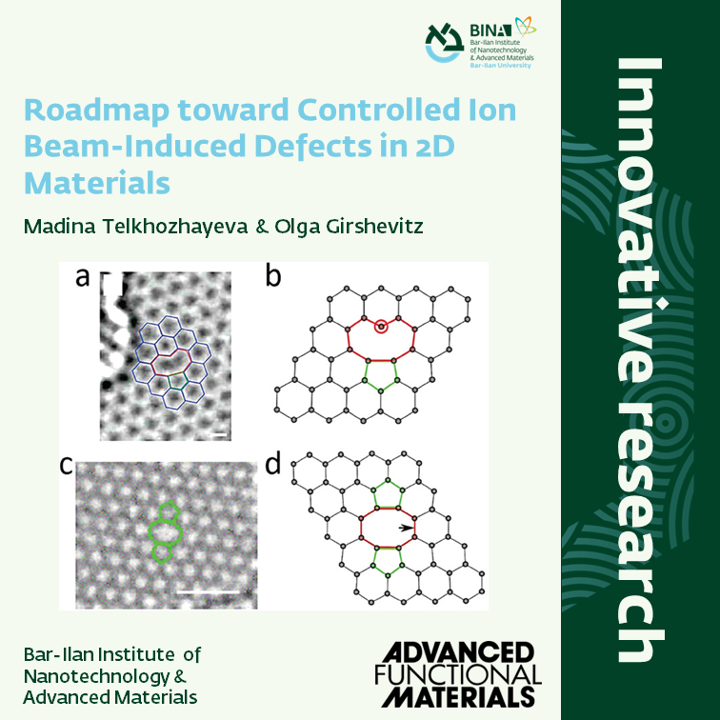 We are thrilled to share the recent review paper of Dr. Madina Telkhozhayeva and Dr. Olga Girshevitz, published in the esteemed Advanced Functional Materials. Their research focuses on the structural defects of atomically thin two-dimensional (2D) materials - a key aspect in tailoring the properties of these materials. They’ve explored ion irradiation, a technique known for its precision and repeatability, to engineer defects in single-atom-thick materials. Their comprehensive review sheds light on how various irradiation parameters influence defect formation in 2D materials. An interesting finding is the role of the substrate in defect yield and formation mechanism. They’ve conducted an in-depth comparison of ion beam-induced defects in both freestanding and supported 2D materials, concentrating on substrate effects. Additionally, they’ve provided a detailed analysis of characterization techniques suitable for each scenario. This work advances our understanding of defect formation and evolution in 2D materials during ion beam irradiation and offers valuable insights into parameter selection for creating desired defects. This could pave the way for designing nanoscale devices with tailored functionality. To learn more, visit https://lnkd.in/drtJMfXT
We are thrilled to share the recent review paper of Dr. Madina Telkhozhayeva and Dr. Olga Girshevitz, published in the esteemed Advanced Functional Materials. Their research focuses on the structural defects of atomically thin two-dimensional (2D) materials - a key aspect in tailoring the properties of these materials. They’ve explored ion irradiation, a technique known for its precision and repeatability, to engineer defects in single-atom-thick materials. Their comprehensive review sheds light on how various irradiation parameters influence defect formation in 2D materials. An interesting finding is the role of the substrate in defect yield and formation mechanism. They’ve conducted an in-depth comparison of ion beam-induced defects in both freestanding and supported 2D materials, concentrating on substrate effects. Additionally, they’ve provided a detailed analysis of characterization techniques suitable for each scenario. This work advances our understanding of defect formation and evolution in 2D materials during ion beam irradiation and offers valuable insights into parameter selection for creating desired defects. This could pave the way for designing nanoscale devices with tailored functionality. To learn more, visit https://lnkd.in/drtJMfXT
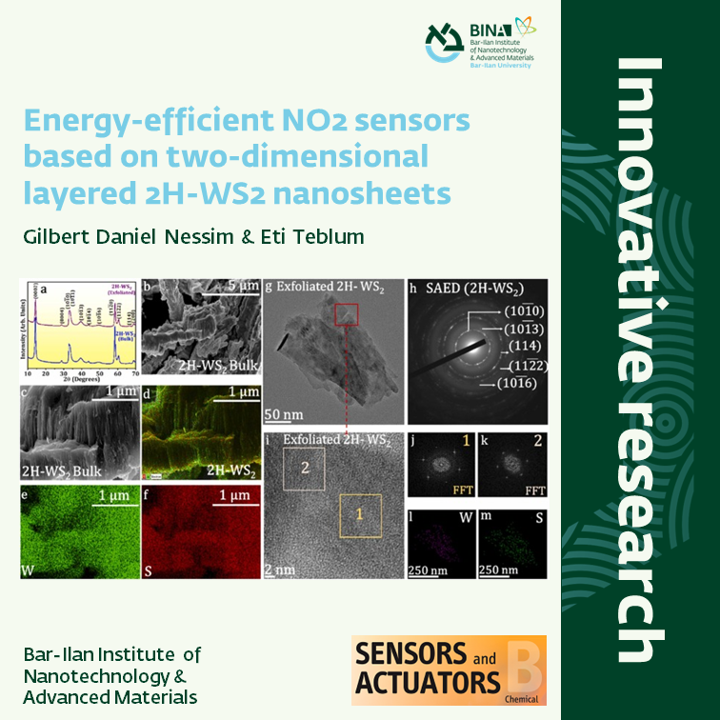 Prof. Daniel Gilbert Nessim, Dr. Rajashree Konar and Prof. Elisabetta Comini from the University of Brescia, Italy, studied layered transition metal dichalcogenides (TMDCs) as the next-generation materials for gas sensing. Their exciting findings have recently been published in Sensors and Actuators: B. Chemical. Prof. They used exfoliated 2 H-WS2 nanosheets to produce high-performance NO2 sensors by conducting thermal annealing at various temperatures to study the oxidation of WS2 and confirm the long-term stability of 2 H-WS2 bulk.
Prof. Daniel Gilbert Nessim, Dr. Rajashree Konar and Prof. Elisabetta Comini from the University of Brescia, Italy, studied layered transition metal dichalcogenides (TMDCs) as the next-generation materials for gas sensing. Their exciting findings have recently been published in Sensors and Actuators: B. Chemical. Prof. They used exfoliated 2 H-WS2 nanosheets to produce high-performance NO2 sensors by conducting thermal annealing at various temperatures to study the oxidation of WS2 and confirm the long-term stability of 2 H-WS2 bulk.
The team fabricated three batches of conductometric sensors from 2 H-WS2 dispersions on electrical transducers using the droplet variation method. These sensors, with two layers (2 L), five layers (5 L), and ten layers (10 L) of WS2 nanosheets, were tested for low NO2 concentrations at different temperatures and relative humidity levels. Bio FastScan Atomic Force Microscopy (AFM, Bruker, AXS, Santa-Barbara, USA) was performed (@BINA) to confirm the layer’s thickness.
The 2 L-WS2-Based sensor outperformed others, showing the highest response at room temperature. It demonstrated excellent repeatability (4 cycles) towards 1 ppm NO2 and long-term stability (over two months). Moreover, it showed full selectivity towards NO2 (1 ppm) at room temperature over NH3 (15 ppm), H2S (15 ppm), ethanol (30 ppm), and acetone (30 ppm).
These findings confirm the potential of 2 H-WS2 nanosheets in fabricating low-power consumption devices with high sensitivity, long-term stability, and excellent selectivity towards NO2, even at high relative humidity levels. For more insights, check out the paper here https://doi.org/10.1016/j.snb.2024.135379
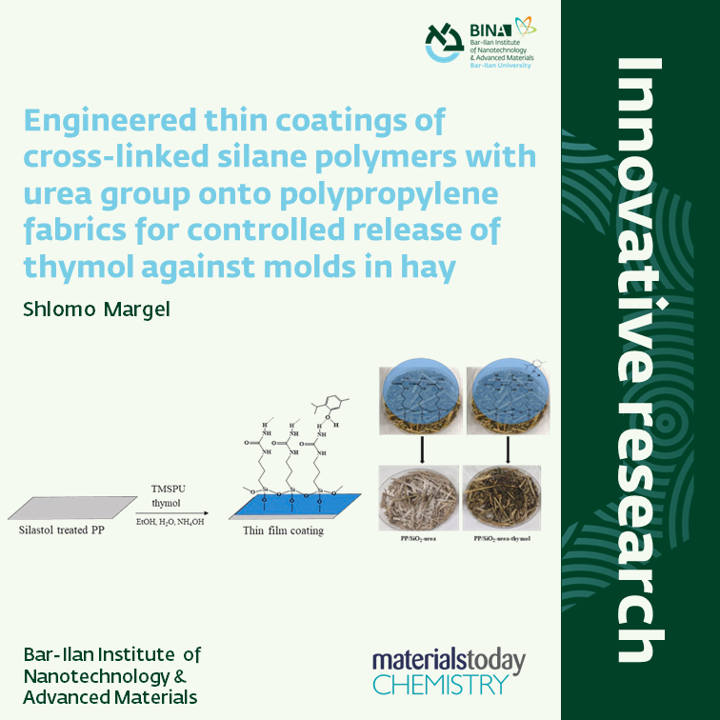 In collaboration with TAMA Ltd, Prof. Shlomo Margel, and his team have recently conducted a study that addresses a significant issue in animal food production. Their findings have been published in the journal Materials Today Chemistry.”
In collaboration with TAMA Ltd, Prof. Shlomo Margel, and his team have recently conducted a study that addresses a significant issue in animal food production. Their findings have been published in the journal Materials Today Chemistry.”
As the world’s population expands, so does the production of animal food sources. However, this growth brings challenges - the susceptibility of hay and other food sources to mold is a serious concern for food quality and safety.
Prof. Margel’s team has proposed an innovative solution to tackle this issue. They’ve developed an anti-mold fungicide that is comprised of thymol bound on a thin silica-urea coating of polypropylene fabrics. This unique coating not only enhances the thermal stability of thymol but also allows for its prolonged release. The team extensively investigated the coating’s composition, morphology, thermal stability, and release rates. The findings revealed that the coating provided efficient protection against mold growth, with no side effects on hay exposed to thymol fumes. This research highlights the potential of this fungicide as a safe and efficient preservative for hay. It represents a significant advancement in safeguarding the quality and safety of our animal feed sources. For more information, please visit the following link https://doi.org/1 0.1016/j.mtchem.2024.102009
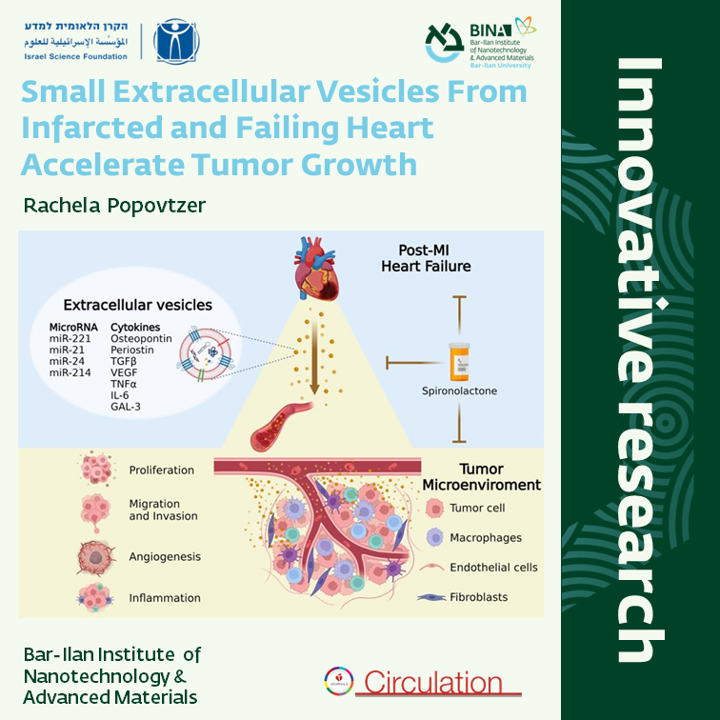 Prof. Rachela Popovtzer (Faculty of Engineering) has recently participated in groundbreaking collaborative research led by Prof. Jonathan Leor of the Neufeld Cardiac Research Institute at Tel Aviv University. The study, published in the esteemed journal Circulation, uncovers a unique mechanism linking heart disease to cancer via cardiac extracellular vesicles carrying pro-tumorigenic factors. Prof. Popovtzer contributed to this study using a gold nanoparticle-based approach for metabolically-targeted computed tomography assessment of tumor spreading and growth. This study can promote the development of more effective treatments for cancer associated with cardiovascular diseases.
Prof. Rachela Popovtzer (Faculty of Engineering) has recently participated in groundbreaking collaborative research led by Prof. Jonathan Leor of the Neufeld Cardiac Research Institute at Tel Aviv University. The study, published in the esteemed journal Circulation, uncovers a unique mechanism linking heart disease to cancer via cardiac extracellular vesicles carrying pro-tumorigenic factors. Prof. Popovtzer contributed to this study using a gold nanoparticle-based approach for metabolically-targeted computed tomography assessment of tumor spreading and growth. This study can promote the development of more effective treatments for cancer associated with cardiovascular diseases.
For more insights, please visit 10.1161/CIRCULATIONAHA.123.066911
 Dr. Shahar Alon and his team have diretly measured, inside biopsies, how cancer cells manipulate immune cells at the molecular level. They recently published their exciting findings in the RNA journal. Their research focused on quantifying the molecular changes that occur when an immune cell comes into contact with a tumor cell. This understanding could unlock new insights into cancer progression and immune evasion mechanisms. Dr. Shahar Alon and his team execute these measurements in situ by expansion sequencing. Expansion sequencing has been a game-changer, enabling them to sequence genes with super-resolution right where they are. They systematically examined whether individual immune cells from specific cell types express genes differently when close to individual tumor cells. Their first step was to demonstrate that a dense mapping of genes in situ can be used to segment cell bodies in 3D. This improved their ability to detect cells that are likely in contact. Next, they employed three different computational approaches to detect the molecular changes triggered by proximity: differential expression analysis, tree-based machine learning classifiers, and matrix factorization analysis. The systematic analysis revealed numerous genes in specific cell types whose expression separates immune cells that are proximal to tumor cells from those that are not. Interestingly, they found a significant overlap between the different detection methods. One remarkable finding was that an order of magnitude more genes are triggered by proximity to tumor cells in CD8 T cells than in CD4 T cells T, which aligns with the ability of CD8 T cells to directly bind Major Histocompatibility Complex (MHC) Class I on tumor cells.
Dr. Shahar Alon and his team have diretly measured, inside biopsies, how cancer cells manipulate immune cells at the molecular level. They recently published their exciting findings in the RNA journal. Their research focused on quantifying the molecular changes that occur when an immune cell comes into contact with a tumor cell. This understanding could unlock new insights into cancer progression and immune evasion mechanisms. Dr. Shahar Alon and his team execute these measurements in situ by expansion sequencing. Expansion sequencing has been a game-changer, enabling them to sequence genes with super-resolution right where they are. They systematically examined whether individual immune cells from specific cell types express genes differently when close to individual tumor cells. Their first step was to demonstrate that a dense mapping of genes in situ can be used to segment cell bodies in 3D. This improved their ability to detect cells that are likely in contact. Next, they employed three different computational approaches to detect the molecular changes triggered by proximity: differential expression analysis, tree-based machine learning classifiers, and matrix factorization analysis. The systematic analysis revealed numerous genes in specific cell types whose expression separates immune cells that are proximal to tumor cells from those that are not. Interestingly, they found a significant overlap between the different detection methods. One remarkable finding was that an order of magnitude more genes are triggered by proximity to tumor cells in CD8 T cells than in CD4 T cells T, which aligns with the ability of CD8 T cells to directly bind Major Histocompatibility Complex (MHC) Class I on tumor cells.
In conclusion, in situ sequencing of an individual biopsy can detect genes likely involved in immune-tumor cell-cell interactions. This is a significant step forward, which might improve the personalization of immunotherapy treatments. The research was led by students Michal Danino and Tal Goldberg under the guidance of Dr. Shahar Alon and Prof. Gonen Singer from the faculty of engineering.
For more insights visit at-https://lnkd.in/dmA-m2CV
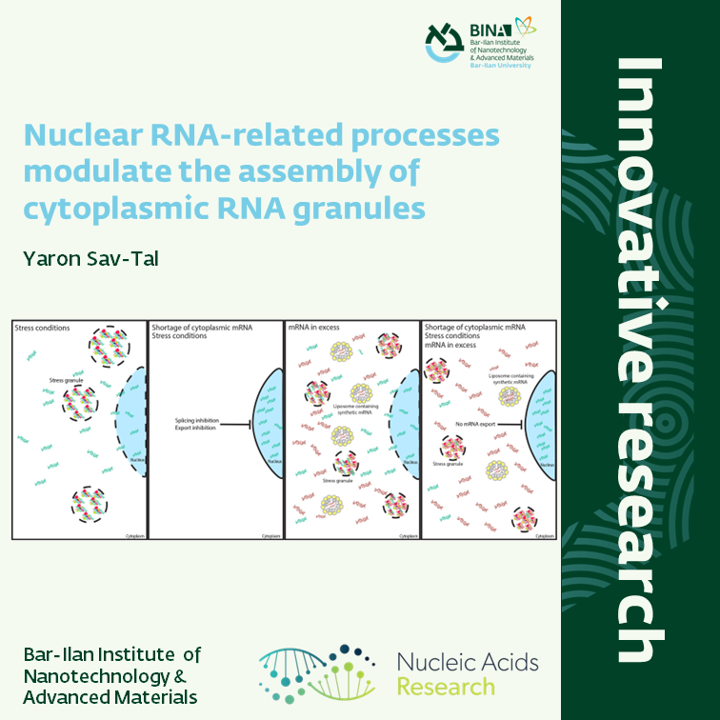 Prof. Yaron Shav-Tal and his team have reported their recent study on Stress Granules (SGs) in the estimated journal Nucleic Acids Research. This fascinating cytoplasmic structure forms under stress conditions due to translation arrest. These granules are a complex mix of RNA-binding proteins, ribosomal subunits, and messenger RNAs (mRNAs). While it’s known that mRNAs play a role in SG formation, the link between SG assembly and nuclear processes involving mRNAs isn’t fully understood. The team has been exploring this connection by examining the impact of inhibiting mRNA transcription, splicing, and export on the assembly of SGs and the related cytoplasmic P body (PB). Their findings revealed that inhibiting these processes reduces the formation of canonical SGs in a manner independent of eukaryotic initiation factor 2 α phosphorylation and alters PB size and quantity. Interestingly, they found that the splicing inhibitor madrasin promotes the assembly of stress-like granules. They’ve also discovered that introducing synthetic mRNAs directly into the cytoplasm is enough to trigger SG assembly, provided stress-associated protein synthesis pathways are activated. Even more exciting, Prof. Shav-Tal’s team found that adding an excess of mRNA to cells with inactive splicing (and therefore low levels of cytoplasmic mRNAs) encourages SG formation under stress conditions. These findings underscore the fundamental role of the cytoplasmic abundance of newly transcribed mRNAs in the assembly of SGs. To learn more, please visit https://lnkd.in/di5tq3Fi
Prof. Yaron Shav-Tal and his team have reported their recent study on Stress Granules (SGs) in the estimated journal Nucleic Acids Research. This fascinating cytoplasmic structure forms under stress conditions due to translation arrest. These granules are a complex mix of RNA-binding proteins, ribosomal subunits, and messenger RNAs (mRNAs). While it’s known that mRNAs play a role in SG formation, the link between SG assembly and nuclear processes involving mRNAs isn’t fully understood. The team has been exploring this connection by examining the impact of inhibiting mRNA transcription, splicing, and export on the assembly of SGs and the related cytoplasmic P body (PB). Their findings revealed that inhibiting these processes reduces the formation of canonical SGs in a manner independent of eukaryotic initiation factor 2 α phosphorylation and alters PB size and quantity. Interestingly, they found that the splicing inhibitor madrasin promotes the assembly of stress-like granules. They’ve also discovered that introducing synthetic mRNAs directly into the cytoplasm is enough to trigger SG assembly, provided stress-associated protein synthesis pathways are activated. Even more exciting, Prof. Shav-Tal’s team found that adding an excess of mRNA to cells with inactive splicing (and therefore low levels of cytoplasmic mRNAs) encourages SG formation under stress conditions. These findings underscore the fundamental role of the cytoplasmic abundance of newly transcribed mRNAs in the assembly of SGs. To learn more, please visit https://lnkd.in/di5tq3Fi
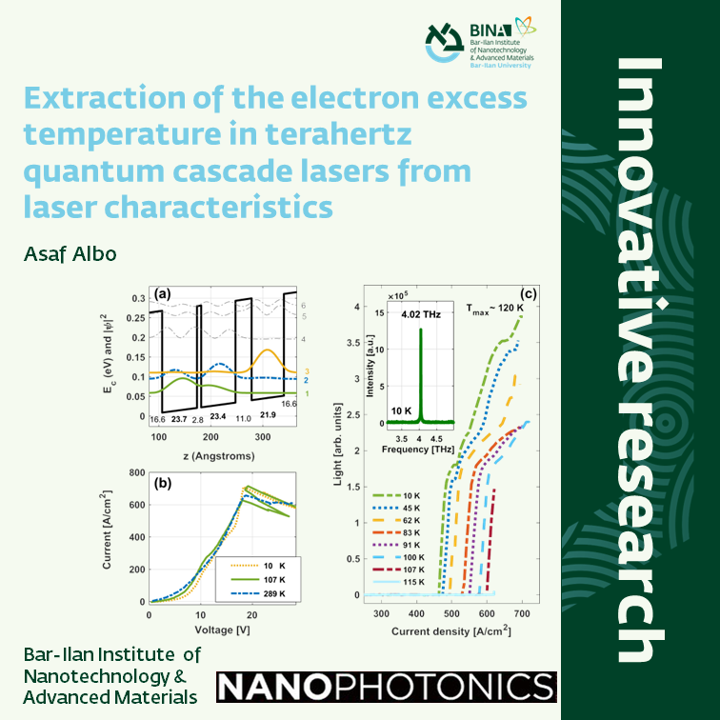 Dr. Asaf Albo and his team developed a novel method to determine the excess electronic temperature of the upper laser level (ULL) in terahertz quantum cascade lasers (THz QCLs) by analyzing the maximum light output power (Pmax) and the current dynamic range ΔJd = ( Jmax − Jth). Their findings were recently published in Nanophotonics. The team has validated this method through rigorous simulation and experimentation, specifically on THz QCLs that support a clean three-level system. This detailed understanding of electronic excess temperatures is crucial for enhancing the temperature performance of THz QCLs. The benefit of their method lies in its simplicity and ease of implementation. It allows for extracting excess electron temperature without intensive experimental effort. This knowledge is set to pave the way for advancements in the temperature performance of THz QCLs, pushing the boundaries beyond the current state-of-the-art. For more insights, visit https://doi.org/10.1515/nanoph-2023-0617
Dr. Asaf Albo and his team developed a novel method to determine the excess electronic temperature of the upper laser level (ULL) in terahertz quantum cascade lasers (THz QCLs) by analyzing the maximum light output power (Pmax) and the current dynamic range ΔJd = ( Jmax − Jth). Their findings were recently published in Nanophotonics. The team has validated this method through rigorous simulation and experimentation, specifically on THz QCLs that support a clean three-level system. This detailed understanding of electronic excess temperatures is crucial for enhancing the temperature performance of THz QCLs. The benefit of their method lies in its simplicity and ease of implementation. It allows for extracting excess electron temperature without intensive experimental effort. This knowledge is set to pave the way for advancements in the temperature performance of THz QCLs, pushing the boundaries beyond the current state-of-the-art. For more insights, visit https://doi.org/10.1515/nanoph-2023-0617
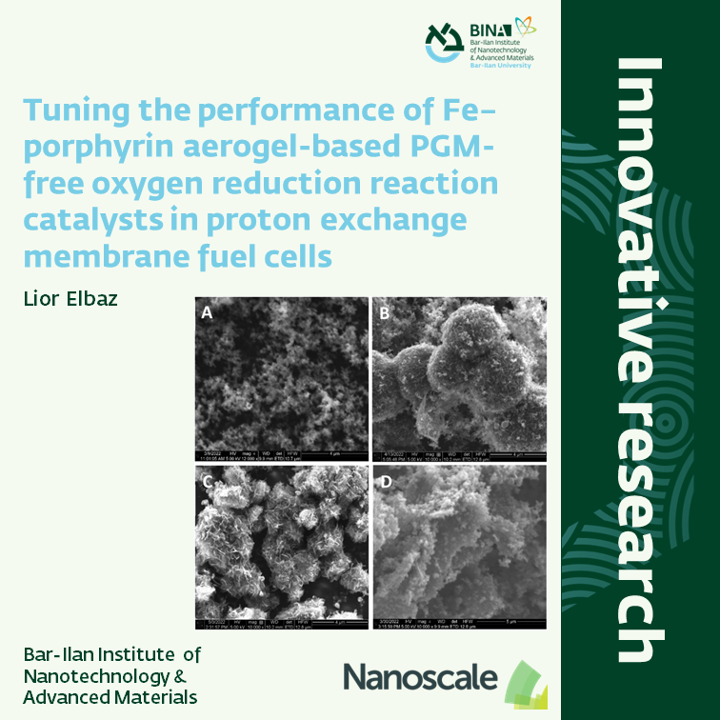 Prof. Lior Elbaz and his team have been working with Fe–N–C catalysts, which are at the forefront of replacing Pt-based catalysts for the oxygen reduction reaction in proton exchange membrane fuel cells. Their findings have been recently published in Nanoscale.
Prof. Lior Elbaz and his team have been working with Fe–N–C catalysts, which are at the forefront of replacing Pt-based catalysts for the oxygen reduction reaction in proton exchange membrane fuel cells. Their findings have been recently published in Nanoscale.
The team focused on optimizing the structure of these catalysts to achieve a high active site density and a hierarchical porous structure. This balance is crucial as it allows efficient mass transport of reactants and products, thereby enhancing the overall performance of the fuel cells.
In their innovative approach, Prof. Elbaz's team synthesized aerogels, covalent organic frameworks known for their ultra-low density, high porosity, and large surface area. The versatility of aerogels in composition and pore structure tuning makes them ideal candidates for catalysis.
The results revealed a tunable Fe–N–C catalyst based on a Fe porphyrin aerogel exhibiting high electrocatalytic oxygen reduction reaction activity. Additionally, the team investigated the porous structure's influence on the overall performance in proton exchange membrane fuel cells. For more insights, visit https://lnkd.in/d7vgvfEp
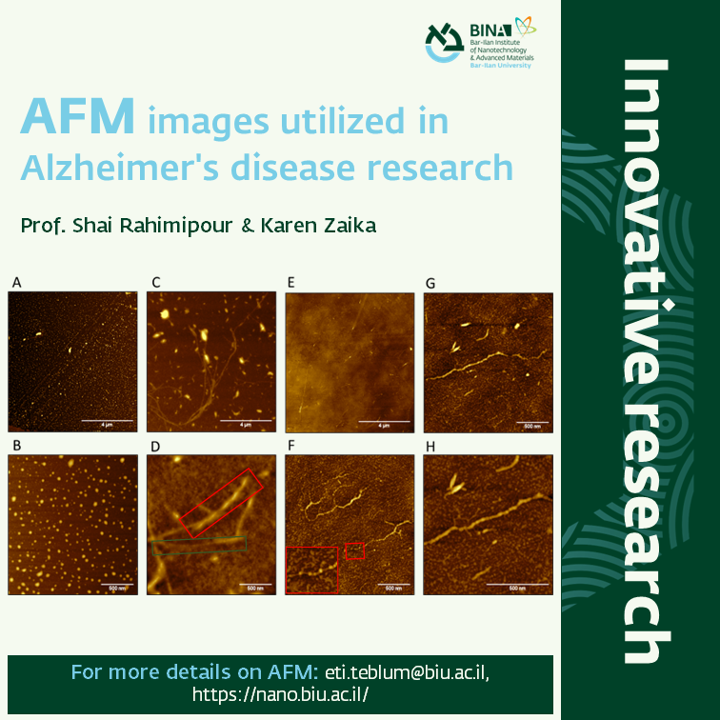 Alzheimer’s disease (AD), the leading cause of dementia, is responsible for up to 80% of all dementia cases. One of the key toxic events in AD is the progressive accumulation of Amyloid beta (Aβ) protein, which leads to synaptic dysfunction and neuronal death. Currently, there are no effective drugs to halt, reverse, or slow down the progression of AD, and all available treatments are merely symptomatic.
Alzheimer’s disease (AD), the leading cause of dementia, is responsible for up to 80% of all dementia cases. One of the key toxic events in AD is the progressive accumulation of Amyloid beta (Aβ) protein, which leads to synaptic dysfunction and neuronal death. Currently, there are no effective drugs to halt, reverse, or slow down the progression of AD, and all available treatments are merely symptomatic.
In a recent study, Prof. Shai Rahimipour and his student, Karen Zaika, demonstrated that liposomes attached to a small molecule drug, an analog of anle138b, can inhibit the aggregation and toxicity of Aβ. Bio FastScan Atomic Force Microscopy (AFM, Bruker, AXS, Santa-Barbara, USA) was performed (Bar Ilan Institute of Nanotechnology and Advanced materials (BINA), Bar Ilan University) to confirm the anti-amyloidogenic activity. Images A&B show liposomes alone, C&D show Aβ alone, and E-H show Aβ treated with the liposomes.
The images reveal that untreated Aβ (C&D) forms large fibrils with a spiral structure, a characteristic of Aβ amyloids. However, when Aβ is treated with liposomes (E-H), there is a significant reduction in the length, width, and quantity of the fibrils. The attachment of the liposomes to the fibrils may suggest their high binding affinity to Aβ species (magnification in red).
These AFM results indicate that liposomes conjugated to an anle138b analog can effectively prevent the formation of Aβ aggregates, suggesting a potential treatment for AD.
For more details on AFM: eti.teblum@biu.ac.il
For more details on AD: karen zaika, shai.rahimipour@biu.ac.il
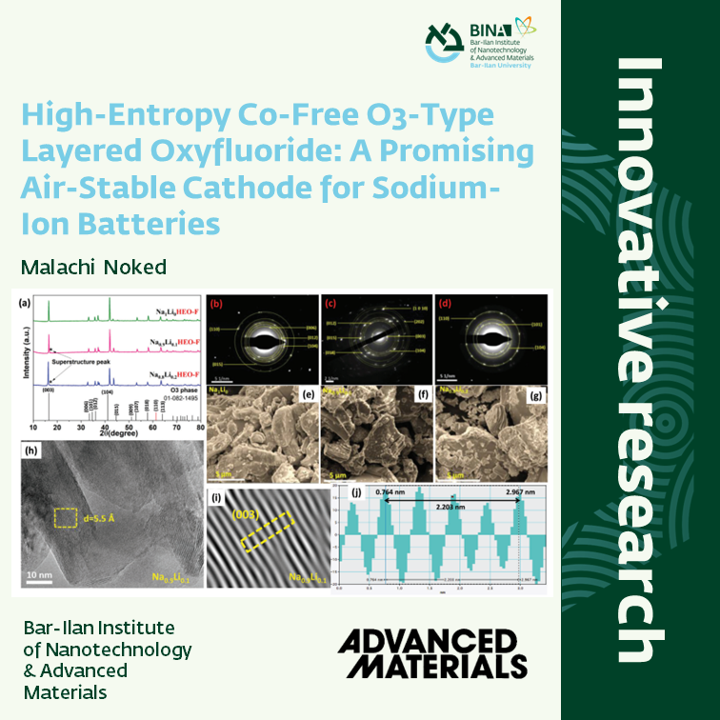 As published in the prestigious Advanced Materials journal, Prof. Malachi Noked and his team have made a significant leap in sodium-ion battery technology. Their innovative research presents a cobalt-free cathode with impressive capacity, achieved through a high-entropy method that blends multiple elements into a single phase. This is a challenging task due to the complex interactions between the elements. Choosing oxyfluoride materials to reduce oxygen loss and adding lithium to the equation enhanced the crystal structure’s stability and improved the kinetics of the battery’s charge and discharge processes. The result? In early testing, a robust cathode with a reversible capacity of 109 mAh g−1 at 2–4 V and 144 mAh g−1 at 2–4.3 V shows great potential for long-term stability. This approach has successfully minimized phase transitions during battery operation, as evidenced by in-depth diffraction studies. Prof. Noked’s promising findings guide future research toward efficient, high-entropy cathodes for sodium-ion batteries. Dive into the full study for a deeper understanding: https://lnkd.in/dzT8w_DB
As published in the prestigious Advanced Materials journal, Prof. Malachi Noked and his team have made a significant leap in sodium-ion battery technology. Their innovative research presents a cobalt-free cathode with impressive capacity, achieved through a high-entropy method that blends multiple elements into a single phase. This is a challenging task due to the complex interactions between the elements. Choosing oxyfluoride materials to reduce oxygen loss and adding lithium to the equation enhanced the crystal structure’s stability and improved the kinetics of the battery’s charge and discharge processes. The result? In early testing, a robust cathode with a reversible capacity of 109 mAh g−1 at 2–4 V and 144 mAh g−1 at 2–4.3 V shows great potential for long-term stability. This approach has successfully minimized phase transitions during battery operation, as evidenced by in-depth diffraction studies. Prof. Noked’s promising findings guide future research toward efficient, high-entropy cathodes for sodium-ion batteries. Dive into the full study for a deeper understanding: https://lnkd.in/dzT8w_DB
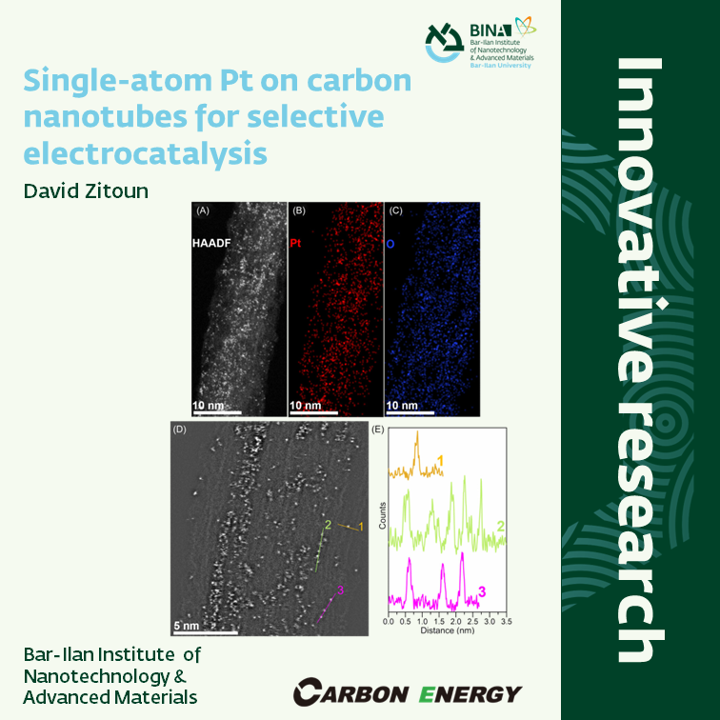 Prof. David Zitoun and his team have been exploring the potential of single atoms as catalysts. This innovative approach promises to significantly reduce the use of critical raw materials like platinum, a key player in hydrogen oxidation reactions (HOR). Their findings were recently published in the esteemed journal Carbon Energy. Using a redox reaction, Prof. Zitoun’s team has successfully synthesized a platinum single electrocatalyst housed within single-walled carbon nanotubes (SWCNTs). Intensive characterizations through electron microscopy, X-ray photoelectron microscopy, and X-ray absorption spectroscopy have confirmed the single-atom nature of the platinum. They studied the electrochemical behavior of the sample in relation to hydrogen and oxygen using the advanced floating electrode technique, developed by Prof. Anthony Kucernak’s team from Imperial College London (UK). This method minimizes mass transport limitations and provides a detailed understanding of the electrocatalyst’s activity.
Prof. David Zitoun and his team have been exploring the potential of single atoms as catalysts. This innovative approach promises to significantly reduce the use of critical raw materials like platinum, a key player in hydrogen oxidation reactions (HOR). Their findings were recently published in the esteemed journal Carbon Energy. Using a redox reaction, Prof. Zitoun’s team has successfully synthesized a platinum single electrocatalyst housed within single-walled carbon nanotubes (SWCNTs). Intensive characterizations through electron microscopy, X-ray photoelectron microscopy, and X-ray absorption spectroscopy have confirmed the single-atom nature of the platinum. They studied the electrochemical behavior of the sample in relation to hydrogen and oxygen using the advanced floating electrode technique, developed by Prof. Anthony Kucernak’s team from Imperial College London (UK). This method minimizes mass transport limitations and provides a detailed understanding of the electrocatalyst’s activity.
The results? The single-atom samples outperformed the state-of-the-art 30% Pt/C in HOR activity while showing almost no oxygen reduction reaction activity in the proton exchange membrane fuel cell operating range. This selective activity towards HOR is a distinctive feature of the catalyst confinement within the SWCNTs. Check the whole study for a deeper understanding
https://lnkd.in/dKh6gB2U
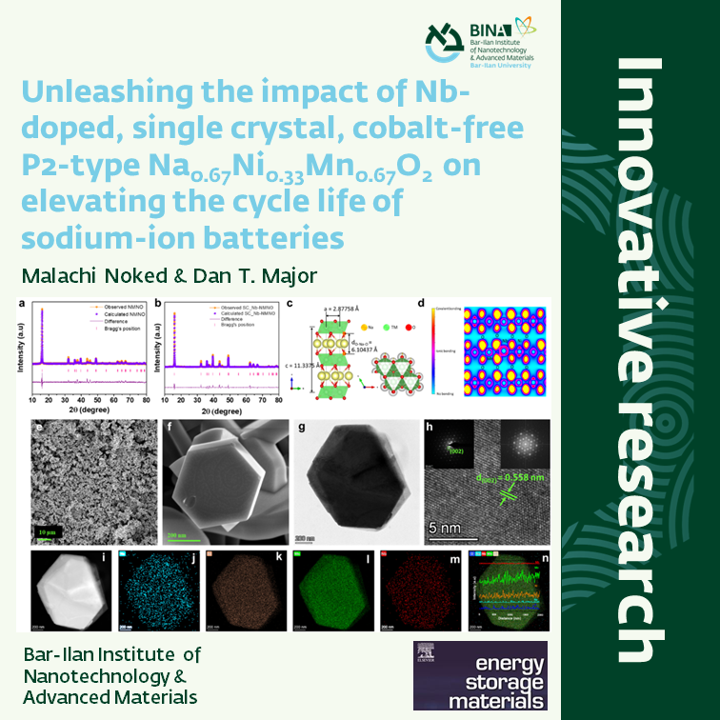 Prof. Dan T. Major, Prof. Malachi Noked, along with Prof. Sagar Mitra (IIT Bombay), and their team recently developed a Nb-doped P2-type single crystal cobalt-free layered oxide cathode material that offers extraordinary cycling stability and high-power performance for Na-ion batteries. Their findings, published in Energy Storage Materials last month, reveal a synergistic stabilization effect in this innovative material. By introducing Nb into the transition metal layer, they reduced the electronic band gap, boosted electronic conductivity, and alleviated ionic diffusion energy barriers. The introduction of Nb results in strong Nb-O bonds, which stabilizes the host structure, and also improves electron and Na+ mobility.
Prof. Dan T. Major, Prof. Malachi Noked, along with Prof. Sagar Mitra (IIT Bombay), and their team recently developed a Nb-doped P2-type single crystal cobalt-free layered oxide cathode material that offers extraordinary cycling stability and high-power performance for Na-ion batteries. Their findings, published in Energy Storage Materials last month, reveal a synergistic stabilization effect in this innovative material. By introducing Nb into the transition metal layer, they reduced the electronic band gap, boosted electronic conductivity, and alleviated ionic diffusion energy barriers. The introduction of Nb results in strong Nb-O bonds, which stabilizes the host structure, and also improves electron and Na+ mobility.
This research achieved a uniform distribution of niobium throughout the single crystal, specifically doped at the nickel site within the bulk, without triggering atomic-scale surface reorganization. The presence of single crystals enhances various kinetic factors, highlighting the profound correlation between structural defects and chemical proliferation, reducing the evolution of oxygen gas. Their P2-type Nb-doped single crystal cathode (Na0.67Ni0.31Mn0.67Nb0.02O2) shows an impressive capacity retention of >95% after 100 cycles at 0.1 C and >90% after 2000 cycles at 1 C. Further practical assessments in complete cell setups with a pre-sodiated hard carbon anode confirm the material’s viability, with capacity retention of over 93% after 100 cycles in a coin cell and approximately 89% in a pouch cell format. This comprehensive study underscores the transformative potential of Nb-doped single crystal cobalt-free P2-type layered oxide cathode materials, marking a significant leap forward in sodium-ion battery technology.
For more insights, please check out the link
https://lnkd.in/djSrQzn8
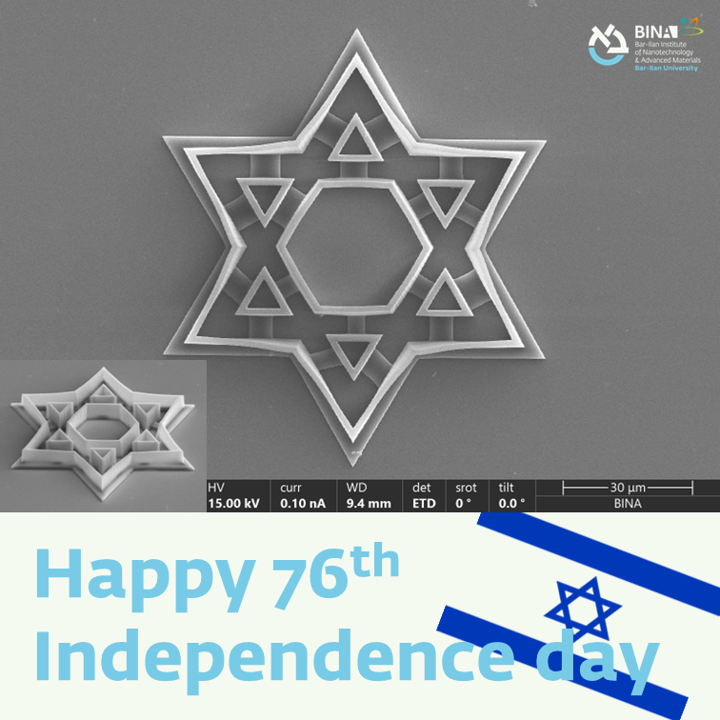 In honor of Israel's 76th Independence Day, we proudly present a special edition Star of David crafted through innovative 3D printing technology.
In honor of Israel's 76th Independence Day, we proudly present a special edition Star of David crafted through innovative 3D printing technology.
Utilizing the cutting-edge Nano-Scribe machine, the Fabrication unit in BINA printed the Star of David in a range of sizes, spanning from 1 micron to 100 microns.
Happy Independence day
For more details about 3D printing- Yossi.abulafia@biu.ac.il
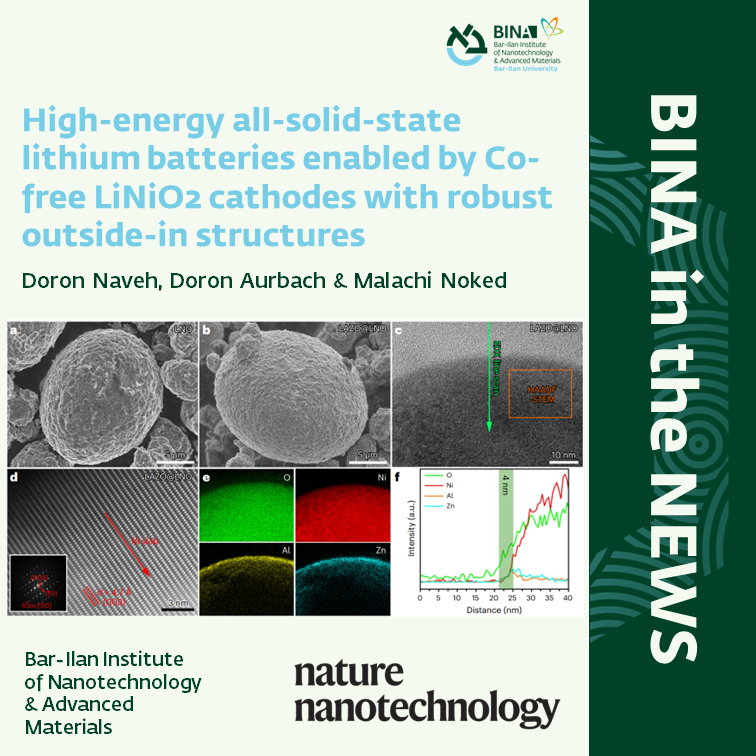 Under the leadership of Prof. Malachi Noked, along with Prof. Doron Aurbach, Prof. Doron Naveh, and their team, a significant advancement has been achieved. This breakthrough has been recognized and published in the highly respected Nature Nanotechnology journal. Their research addresses a pivotal issue in the advancement of all-solid-state lithium batteries (ASSLBs)—balancing cost-efficiency with performance. The team introduced a sulfide-based ASSLB featuring a high-energy, cobalt-free LiNiO2 cathode, distinguished by its robust structure. This innovation stems from a high-pressure oxygen synthesis process, followed by the atomic layer deposition of an ultrathin, multi-element LixAlyZnzOδ protective layer. This layer not only fortifies the cathode's structure but also improves the dynamics at the interface, reducing degradation and side reactions. The result? An ASSLB that boasts an impressive areal capacity of 4.65 mAh cm−2, a specific cathode capacity of 203 mAh g−1, remarkable cycling stability with 92% capacity retention over 200 cycles, and commendable rate capability, maintaining 93 mAh g−1 at a 2C rate. This study paves the way for cost-effective yet high-performing ASSLBs, circumventing the need for expensive materials traditionally used in cathodes and coatings. It's a significant step forward in our quest for sustainable energy solutions. Dive into the full paper for a deeper understanding at https://doi.org/10.1038/s41565-023-01519-8
Under the leadership of Prof. Malachi Noked, along with Prof. Doron Aurbach, Prof. Doron Naveh, and their team, a significant advancement has been achieved. This breakthrough has been recognized and published in the highly respected Nature Nanotechnology journal. Their research addresses a pivotal issue in the advancement of all-solid-state lithium batteries (ASSLBs)—balancing cost-efficiency with performance. The team introduced a sulfide-based ASSLB featuring a high-energy, cobalt-free LiNiO2 cathode, distinguished by its robust structure. This innovation stems from a high-pressure oxygen synthesis process, followed by the atomic layer deposition of an ultrathin, multi-element LixAlyZnzOδ protective layer. This layer not only fortifies the cathode's structure but also improves the dynamics at the interface, reducing degradation and side reactions. The result? An ASSLB that boasts an impressive areal capacity of 4.65 mAh cm−2, a specific cathode capacity of 203 mAh g−1, remarkable cycling stability with 92% capacity retention over 200 cycles, and commendable rate capability, maintaining 93 mAh g−1 at a 2C rate. This study paves the way for cost-effective yet high-performing ASSLBs, circumventing the need for expensive materials traditionally used in cathodes and coatings. It's a significant step forward in our quest for sustainable energy solutions. Dive into the full paper for a deeper understanding at https://doi.org/10.1038/s41565-023-01519-8
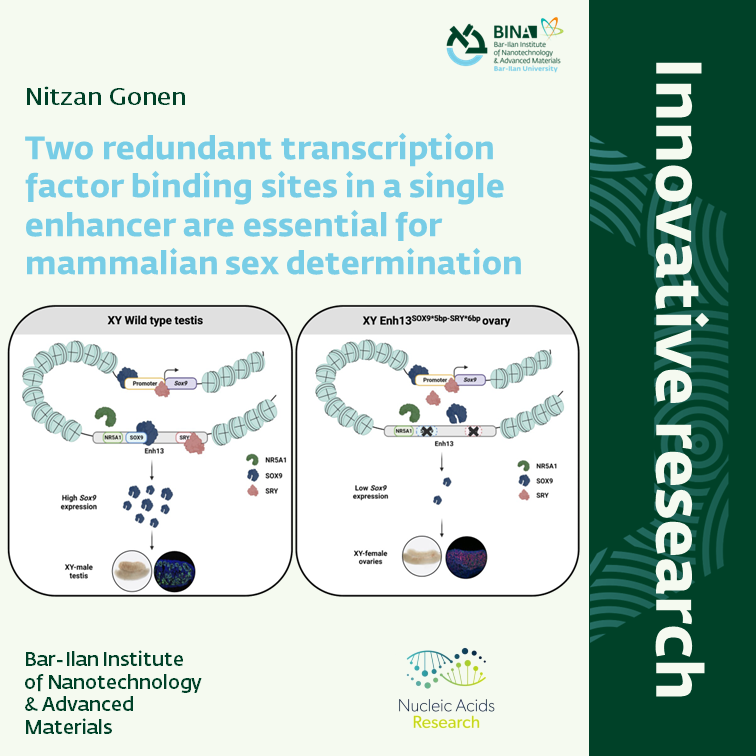 Dr. Nitzan Gonen and her team have recently published exciting research on understanding male development in mammals at Nucleic Acids Research. Their study sheds light on the critical role of two SOX transcription factors, SRY and SOX9, in embryonic testis. They previously discovered that the deletion of Enhancer 13 (Enh13, 557 bp long) of the Sox9 gene can lead to XY male-to-female sex reversal. While individual microdeletions in Enh13’s transcription factor binding sites (TFBS) still allow for normal testicular development, the combined microdeletions of just two SRY/SOX binding motifs can fully abolish Enh13 activity, leading to XY male-to-female sex reversal. This underscores the importance of these few nucleotides of non-coding DNA for proper male development. Interestingly, Dr. Gonen found that the nature of these TFBS mutations can lead to dramatically different phenotypic outcomes. This finding explains the distinct clinical outcomes observed in patients harboring different variants of the same enhancer.
Dr. Nitzan Gonen and her team have recently published exciting research on understanding male development in mammals at Nucleic Acids Research. Their study sheds light on the critical role of two SOX transcription factors, SRY and SOX9, in embryonic testis. They previously discovered that the deletion of Enhancer 13 (Enh13, 557 bp long) of the Sox9 gene can lead to XY male-to-female sex reversal. While individual microdeletions in Enh13’s transcription factor binding sites (TFBS) still allow for normal testicular development, the combined microdeletions of just two SRY/SOX binding motifs can fully abolish Enh13 activity, leading to XY male-to-female sex reversal. This underscores the importance of these few nucleotides of non-coding DNA for proper male development. Interestingly, Dr. Gonen found that the nature of these TFBS mutations can lead to dramatically different phenotypic outcomes. This finding explains the distinct clinical outcomes observed in patients harboring different variants of the same enhancer.
To get more information, visit https://lnkd.in/dwXefgtV
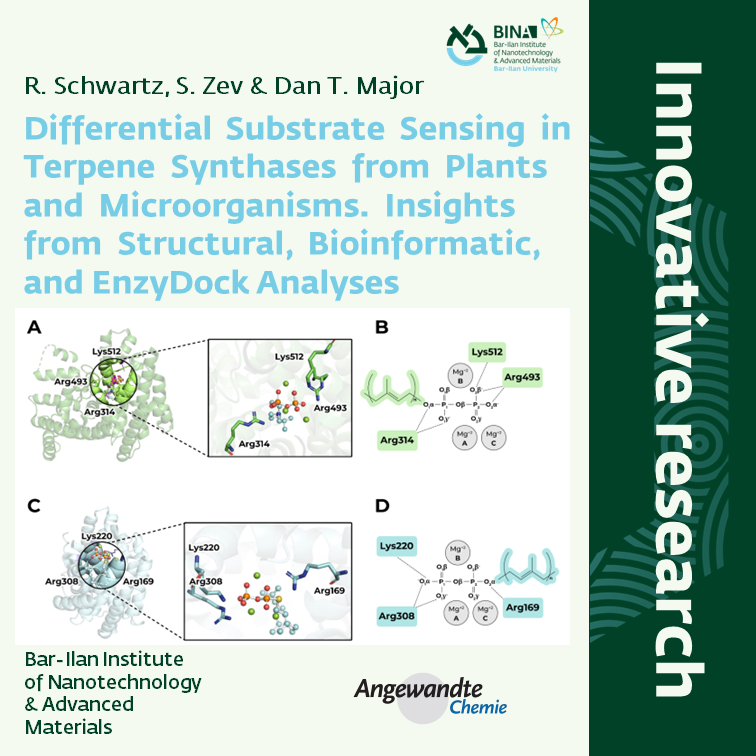 A recent publication in the esteemed Angewandte Chemie journal features the innovative research of Prof. Dan T. Major and his team on the role of terpene synthases (TPS). Terpenes, a broad category of substances naturally produced by plants, bacteria, and fungi, have a range of medicinal applications. These include acting as anti-inflammatories, antibiotics, mood stabilizers, and even exhibiting anti-cancer properties. Additionally, terpenes contribute to the diverse array of natural fragrances found in citrus fruits, roses, cannabis, and more.
A recent publication in the esteemed Angewandte Chemie journal features the innovative research of Prof. Dan T. Major and his team on the role of terpene synthases (TPS). Terpenes, a broad category of substances naturally produced by plants, bacteria, and fungi, have a range of medicinal applications. These include acting as anti-inflammatories, antibiotics, mood stabilizers, and even exhibiting anti-cancer properties. Additionally, terpenes contribute to the diverse array of natural fragrances found in citrus fruits, roses, cannabis, and more.
In their innovative study, Prof. Major's team has, for the first time, identified notable differences in how these substances are synthesized in plants as opposed to bacteria and fungi. Their research methodology involved various computational tools, spanning both computational biology (for sequence comparison and motif identification) and computational chemistry (for predicting the geometry of the precursor substance that forms terpenes within the enzymes that produce them). One of these tools, specifically tailored for this study, was developed in Prof. Major's laboratory.
This pioneering research holds the potential to produce precisely and on a large scale terpenes for various medicinal and industrial applications. For more detailed insights, please visit the published article at https://onlinelibrary.wiley.com/doi/10.1002/anie.202400743
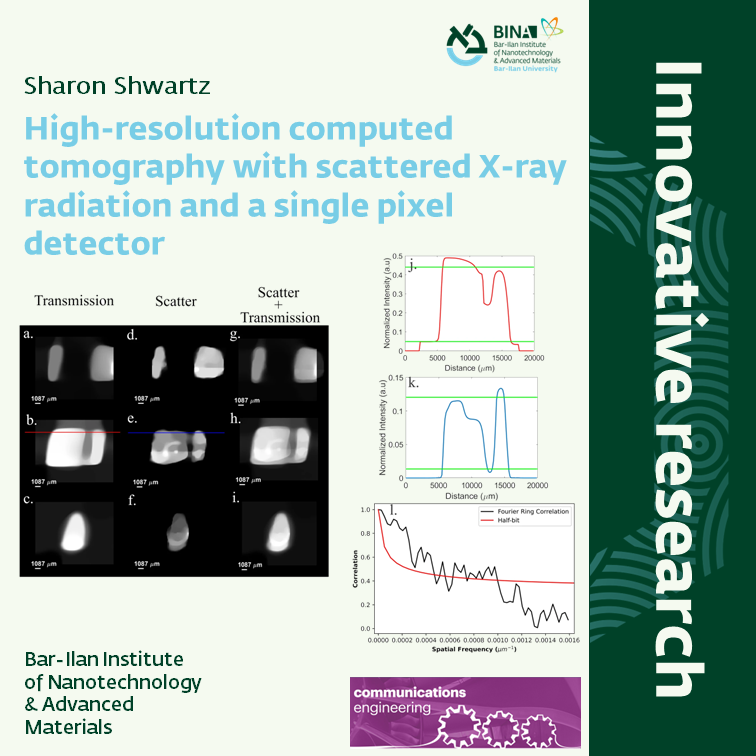 New technique for improving CT scan resolution
New technique for improving CT scan resolution
A technique for improving the resolution of X-ray computed tomography (CT) scans is presented in a proof-of-principle study published in Communications Engineering.
The technique developed by Sharon Shwartz, Adi Ben-Yehuda and colleagues combines a single-pixel imaging method with a deep learning algorithm and a CT image reconstruction tool to measure scattered radiation produced during CT scanning, which can blur and distort images. They used their technique to reconstruct a high resolution three-dimensional CT image of a cow bone sample. They estimate the resolution of the images obtained using their method to be 500 micrometres, which they suggest is approximately an order of magnitude higher than the typical resolution of scattered X-ray imaging techniques.
The authors suggest that, with further development, their technique could have the potential to enhance the image quality of medical CT images by enabling small and complex details to be viewed at lower radiation doses, which could minimise radiation exposure for patients.
visit https://lnkd.in/df8MRiDn
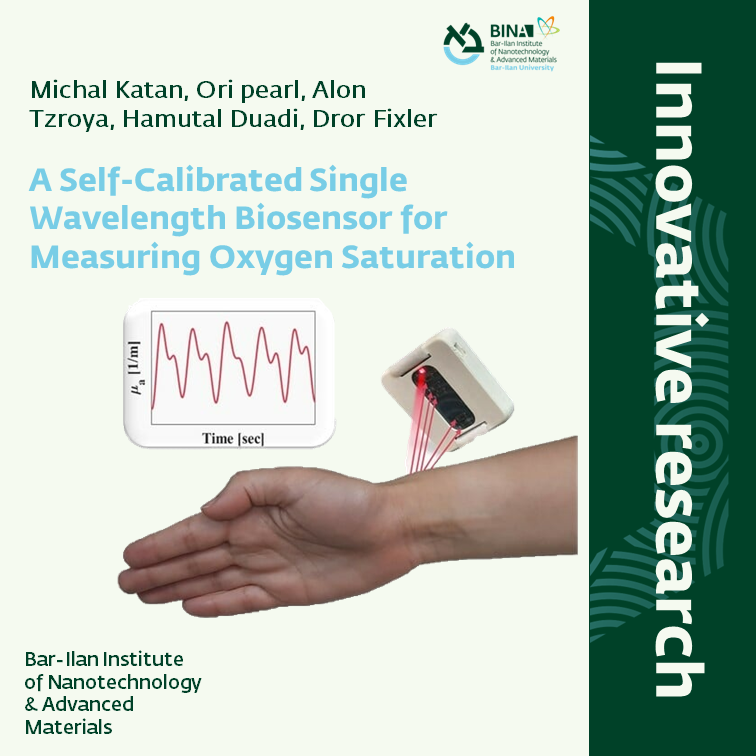 New publication from the laboratory of Dror Fixler, in which a groundbreaking biosensor for the accurate measurement of blood oxygen is presented .
New publication from the laboratory of Dror Fixler, in which a groundbreaking biosensor for the accurate measurement of blood oxygen is presented .
With conventional methods, scattering is often overlooked, leading to errors in blood oxygen measurement. Our optical biosensor, which utilizes the Iso-Pathlength (IPL) point, isolates absorption from scattering, enabling accurate extraction of oxygen saturation.
With a single light source and multiple photodetectors (PDs), our biosensor achieves remarkable accuracy with a margin of error of only 0.5%. It has been tested on thirty-eight people under normal and extreme conditions, proving its reliability in real-life scenarios.
This innovation promises more reliable and accessible blood oxygen monitoring.
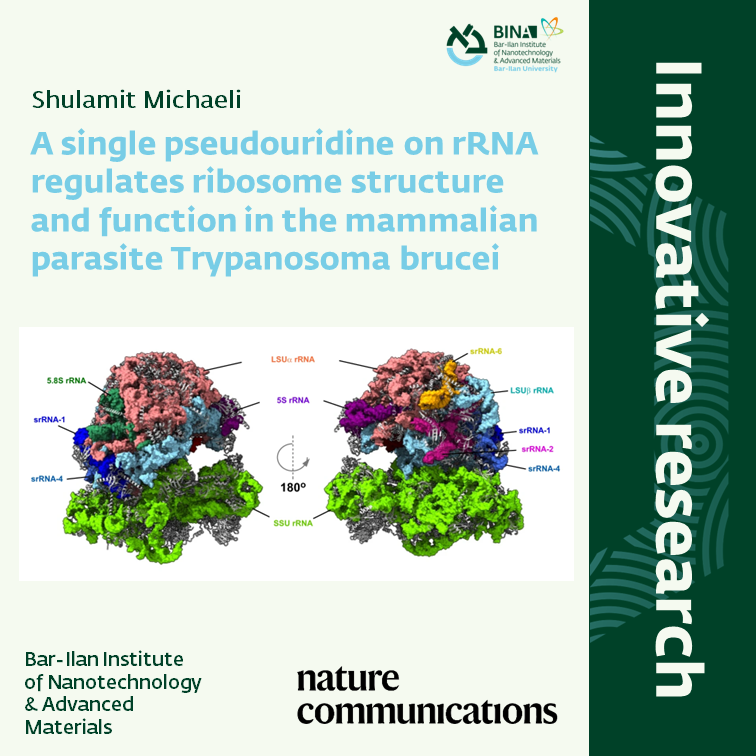 Prof. Shulamit Michaeli in collaboration with Prof. Ada Yunath recently unveiled the intricate dance of Trypanosomes at Nature Communications. These notorious protozoan parasites cycle between insect and mammalian hosts, triggering sleeping sickness. Prof. Michaeli and her team mapped the elusive changes of pseudouridine (Ψ) modification on rRNA across the parasite’s two life stages, employing not one but four genome-wide approaches. The results? Knocking out the snoRNAs that guide Ψ on helix 69 (H69) of the large rRNA subunit proved to be lethal, highlighting their critical role. But it gets more intriguing. A single knock-out of a snoRNA guiding Ψ530 on H69 shook up the 80S monosome’s composition, impacting the translation of a specific protein subset. Supported by a high-resolution cryo-EM structure, their study suggests that altering rRNA modifications could lead to ribosomes with a preference for translating proteins beneficial to the parasite’s state. This discovery advances our understanding of parasitic mechanisms and opens the door to targeted treatments.
Prof. Shulamit Michaeli in collaboration with Prof. Ada Yunath recently unveiled the intricate dance of Trypanosomes at Nature Communications. These notorious protozoan parasites cycle between insect and mammalian hosts, triggering sleeping sickness. Prof. Michaeli and her team mapped the elusive changes of pseudouridine (Ψ) modification on rRNA across the parasite’s two life stages, employing not one but four genome-wide approaches. The results? Knocking out the snoRNAs that guide Ψ on helix 69 (H69) of the large rRNA subunit proved to be lethal, highlighting their critical role. But it gets more intriguing. A single knock-out of a snoRNA guiding Ψ530 on H69 shook up the 80S monosome’s composition, impacting the translation of a specific protein subset. Supported by a high-resolution cryo-EM structure, their study suggests that altering rRNA modifications could lead to ribosomes with a preference for translating proteins beneficial to the parasite’s state. This discovery advances our understanding of parasitic mechanisms and opens the door to targeted treatments.
For more details, visit https://lnkd.in/d3htjaeK
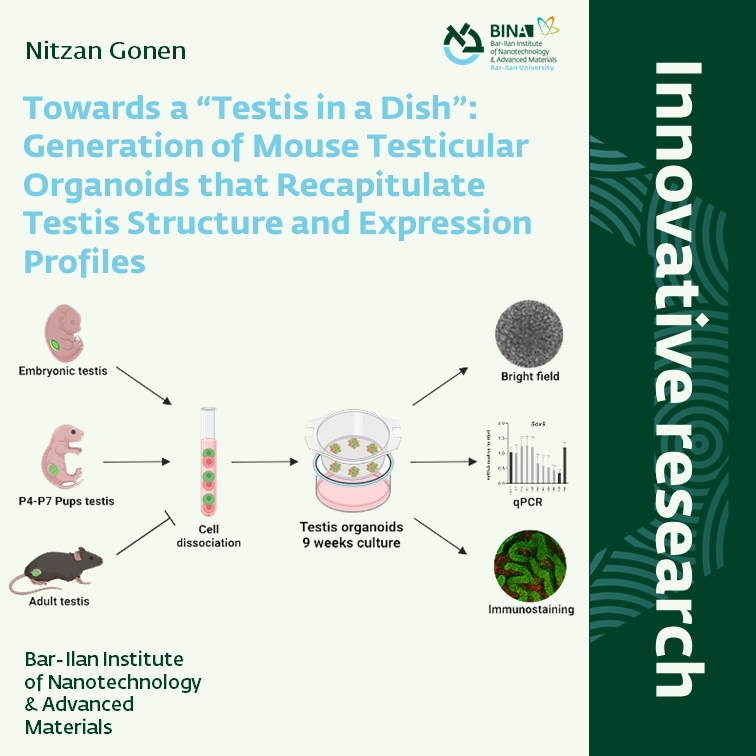 Exciting Breakthrough in Testis Modeling: Introducing Testis Organoids!
Exciting Breakthrough in Testis Modeling: Introducing Testis Organoids!
Dr. Nitzan Gonen's latest paper presents a significant advancement in the field of male reproductive health research by establishing the first-ever testis organoid model. This innovative model holds immense potential for understanding and treating disorders of sex development and male infertility.
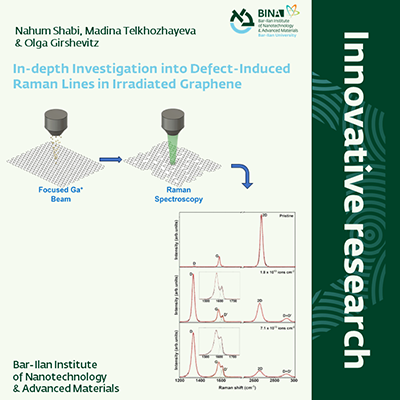 A recent study delving into the effects of Ga ion irradiation on freestanding monolayer graphene, with a specific focus on the behavior of defect-induced Raman lines, was initiated by Nahum Shabi and published in Surfaces and Interfaces. The article was authored by three members of the BINA team: Nahum Shabi, Dr. Olga Girshevitz, and Dr. Madina Telkhozhayeva.
A recent study delving into the effects of Ga ion irradiation on freestanding monolayer graphene, with a specific focus on the behavior of defect-induced Raman lines, was initiated by Nahum Shabi and published in Surfaces and Interfaces. The article was authored by three members of the BINA team: Nahum Shabi, Dr. Olga Girshevitz, and Dr. Madina Telkhozhayeva.
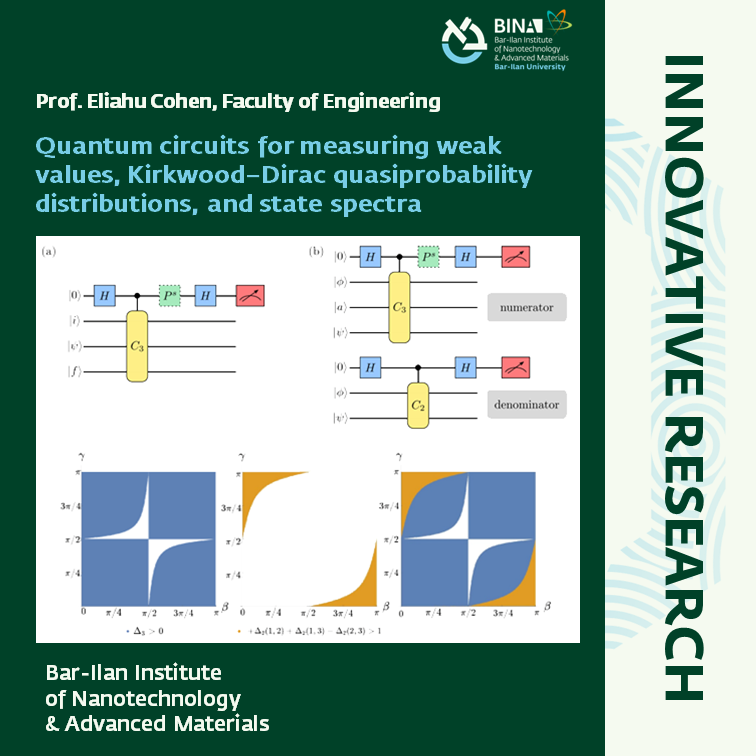 Exciting breakthrough! New article written by Dr. Eliahu Cohen's group, in collaboration with Prof. Ernesto Galvão's group at INL, introduces a novel approach that connects and unifies key quantities crucial in quantum computation, sensing, simulation, and communication. The work presents Bargmann invariants as foundational building blocks, revealing unique quantum properties. Coherence, a fundamental phenomenon across physics, underlies these quantities, broadening its scope beyond conventional optics towards sets of quantum states. "Our quantum circuits, developed through this approach, enable straightforward measurement of important quantities using quantum computers", says Dr. Cohen. The research is a result of a two-year collaboration with INL, initiated and partially funded by BINA.
Exciting breakthrough! New article written by Dr. Eliahu Cohen's group, in collaboration with Prof. Ernesto Galvão's group at INL, introduces a novel approach that connects and unifies key quantities crucial in quantum computation, sensing, simulation, and communication. The work presents Bargmann invariants as foundational building blocks, revealing unique quantum properties. Coherence, a fundamental phenomenon across physics, underlies these quantities, broadening its scope beyond conventional optics towards sets of quantum states. "Our quantum circuits, developed through this approach, enable straightforward measurement of important quantities using quantum computers", says Dr. Cohen. The research is a result of a two-year collaboration with INL, initiated and partially funded by BINA.
https://lnkd.in/eMTg7gQq
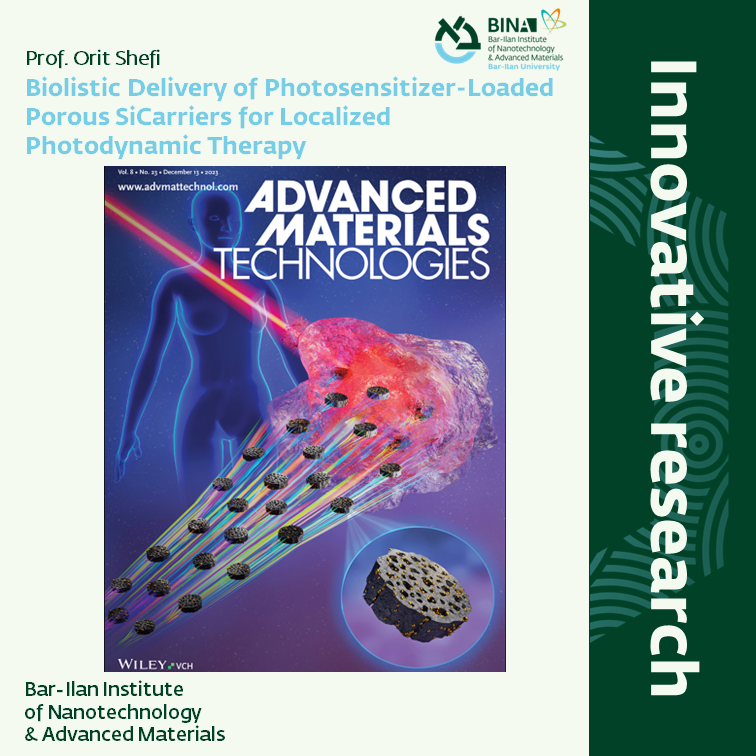 New article written by Prof. Orit Shefi in collaboration with Prof. Ester Segal from the Technion, demonstrating targeted cancer treatment by biolistic delivery of porous silicon chips loaded with light activated drug.
New article written by Prof. Orit Shefi in collaboration with Prof. Ester Segal from the Technion, demonstrating targeted cancer treatment by biolistic delivery of porous silicon chips loaded with light activated drug.



